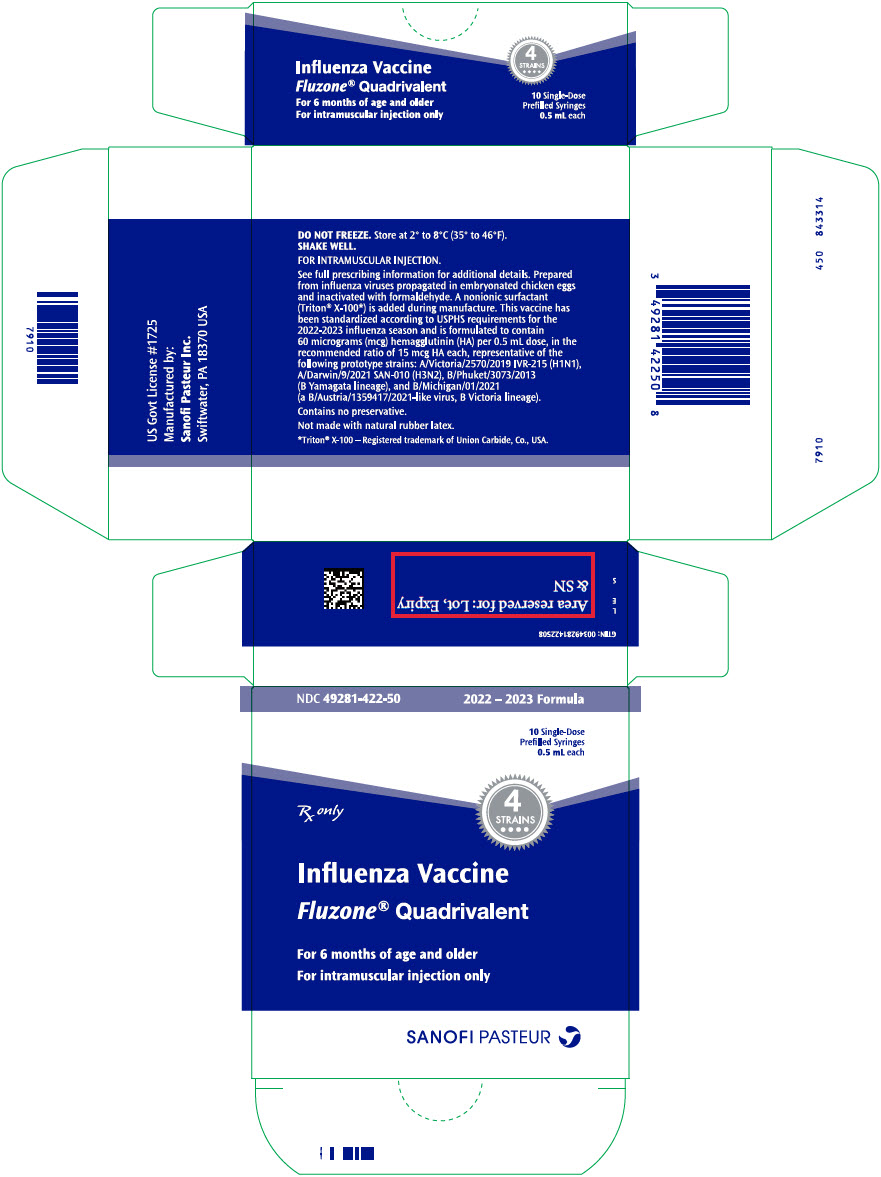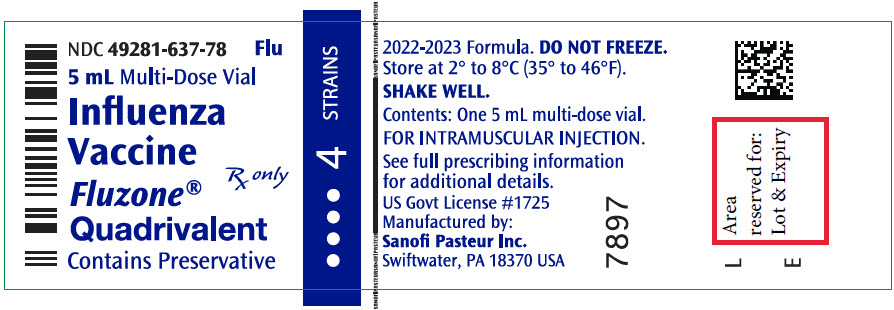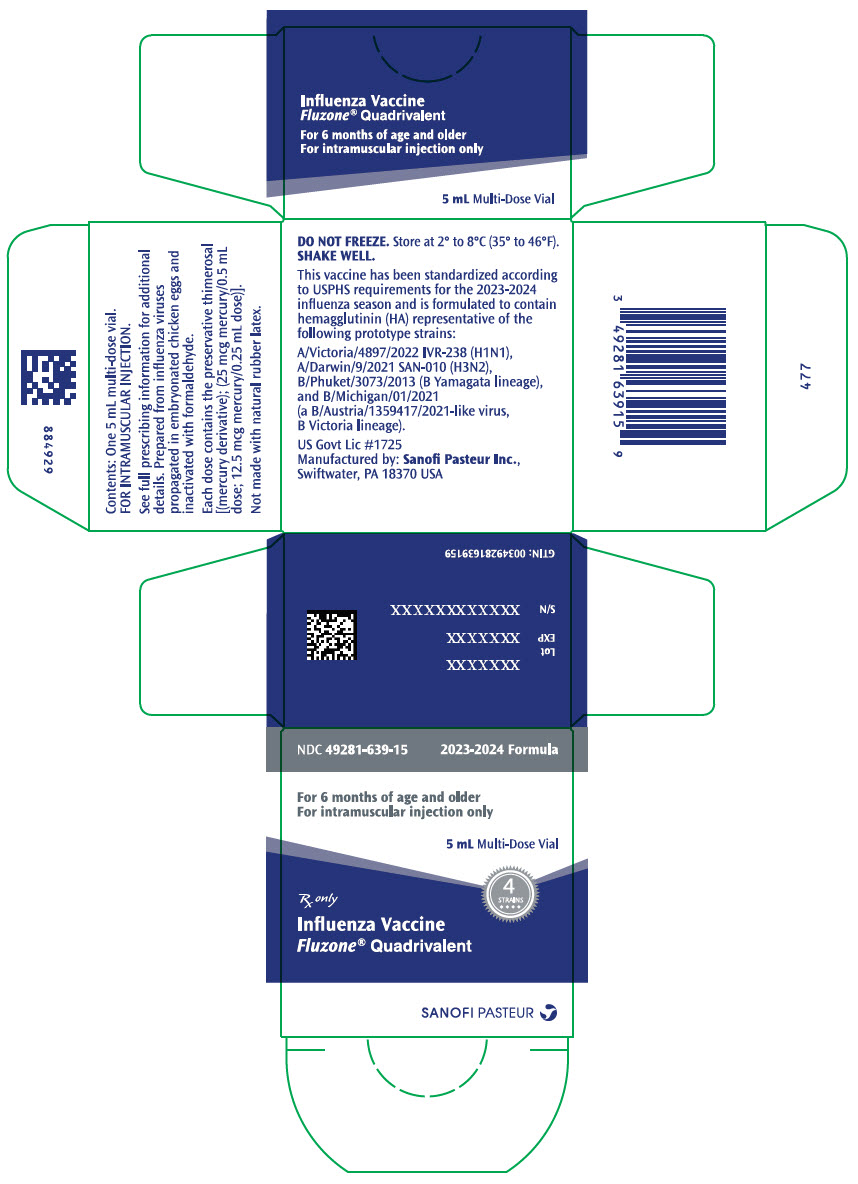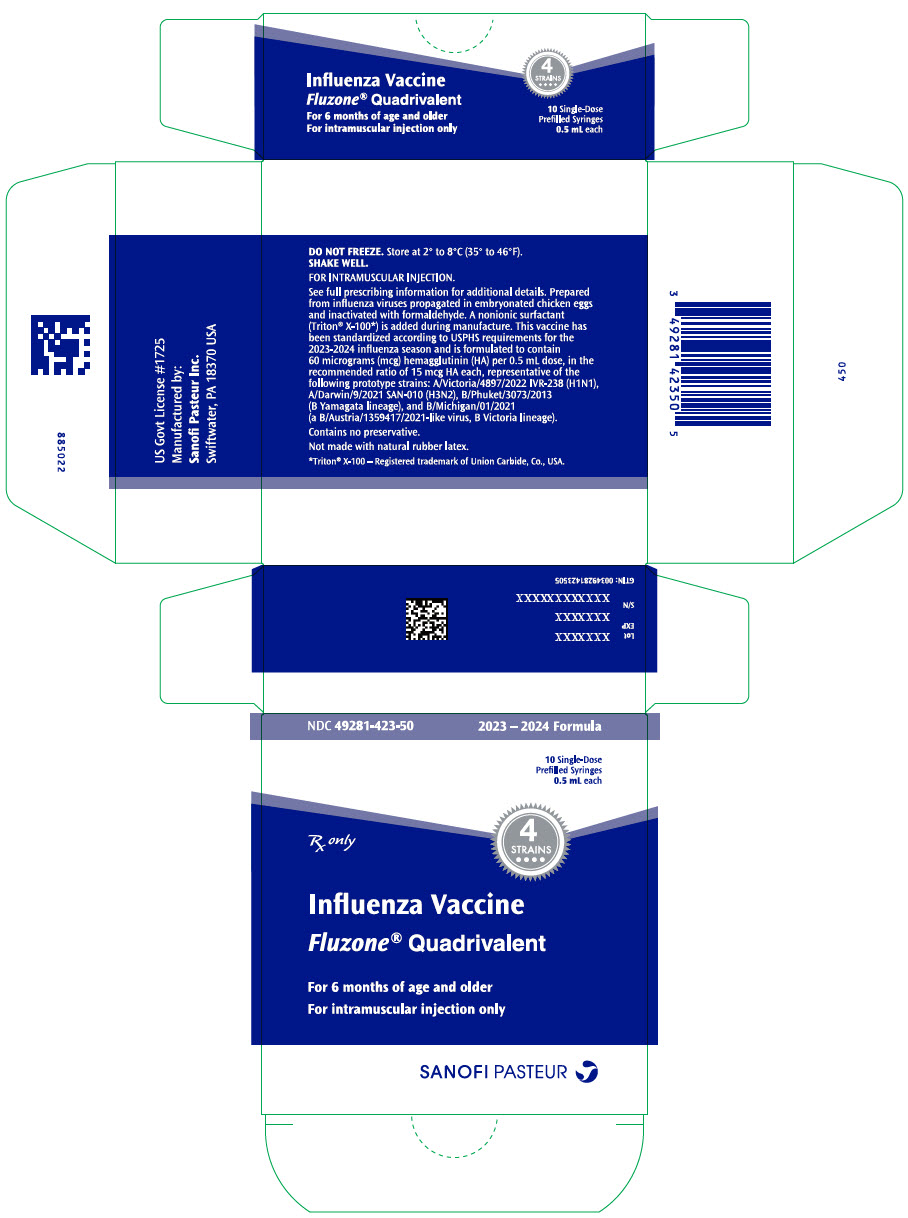Label: FLUZONE QUADRIVALENT NORTHERN HEMISPHERE (influenza a virus a/victoria/2570/2019 ivr-215 (h1n1) antigen (formaldehyde inactivated), influenza a virus a/darwin/9/2021 san-010 (h3n2) antigen (formaldehyde inactivated), influenza b virus b/phuket/3073/2013 antigen (formaldehyde inactivated), and influenza b virus b/michigan/01/2021 antigen- formaldehyde inactivated injection, suspension
FLUZONE QUADRIVALENT .......ivated)) injection, suspension
FLUZONE QUADRIVALENT NORTHERN HEMISPHERE (influenza a virus a/victoria/4897/2022 ivr-238 (h1n1) antigen (formaldehyde inactivated), influenza a virus a/darwin/9/2021 san-010 (h3n2) antigen (formaldehyde inactivated), influenza b virus b/phuket/3073/2013 antigen (formaldehyde inactivated), and influenza b virus b/michigan/01/2021 antigen- formaldehyde inactivated injection, suspension
-
NDC Code(s):
49281-418-50,
49281-418-88,
49281-420-50,
49281-420-88, view more49281-421-10, 49281-421-50, 49281-421-58, 49281-421-88, 49281-422-10, 49281-422-50, 49281-422-58, 49281-422-88, 49281-423-50, 49281-423-88, 49281-519-00, 49281-519-25, 49281-629-15, 49281-629-78, 49281-631-15, 49281-631-78, 49281-633-15, 49281-633-78, 49281-635-15, 49281-635-78, 49281-637-15, 49281-637-78, 49281-639-15, 49281-639-78
- Packager: Sanofi Pasteur Inc.
- Category: VACCINE LABEL
Drug Label Information
Updated September 14, 2023
If you are a healthcare professional or from the pharmaceutical industry please visit this version.
- Download DRUG LABEL INFO: PDF XML
- Official Label (Printer Friendly)
-
HIGHLIGHTS OF PRESCRIBING INFORMATION
These highlights do not include all the information needed to use Fluzone® Quadrivalent safely and effectively. See full prescribing information for Fluzone Quadrivalent.
Fluzone Quadrivalent (Influenza Vaccine)
Suspension for Intramuscular Injection
2023-2024 Formula
Initial U.S. Approval (Fluzone Quadrivalent): 2013INDICATIONS AND USAGE
DOSAGE AND ADMINISTRATION
- For intramuscular use only (2)
Age Vaccination Status Dose Schedule "-" Indicates information is not applicable - *
- The schedule can be completed as two 0.25-mL doses ≥4 weeks apart, two 0.5-mL doses ≥4 weeks apart, or any combination of 2 doses (either 0.25 mL or 0.5 mL) administered ≥4 weeks apart.
- †
- To determine if 1 or 2 doses are required, refer to Advisory Committee on Immunization Practices annual recommendations on prevention and control of influenza with vaccines.
6 months through 35 months Not previously vaccinated with influenza vaccine or unknown vaccination history Two doses, either 0.25 mL or 0.5 mL* Administer at least 4 weeks apart Previously vaccinated with influenza vaccine One or two doses†, either 0.25 mL or 0.5 mL* If two doses, administer at least 4 weeks apart 36 months through 8 years Not previously vaccinated with influenza vaccine or unknown vaccination history Two 0.5 mL doses Administer at least 4 weeks apart Previously vaccinated with influenza vaccine One or two 0.5 mL doses† If two doses, administer at least 4 weeks apart 9 years and older - One 0.5 mL dose - DOSAGE FORMS AND STRENGTHS
Suspension for injection supplied in 2 presentations: prefilled single-dose syringe (clear plunger rod), 0.5 mL and multi-dose vial, 5 mL. (3)
CONTRAINDICATIONS
Severe allergic reaction (e.g., anaphylaxis) to any component of the vaccine, including egg protein, or after previous dose of any influenza vaccine. (4)
WARNINGS AND PRECAUTIONS
- If Guillain-Barré syndrome (GBS) has occurred within 6 weeks following previous influenza vaccination, the decision to give Fluzone Quadrivalent should be based on careful consideration of the potential benefits and risks. (5.1)
ADVERSE REACTIONS
- In children 6 months through 35 months of age, the most common (≥10%) injection-site reactions were pain (57%) or tenderness (47%–54%), erythema (23%–37%), and swelling (13%–22%); the most common solicited systemic adverse reactions were irritability (47%–54%), abnormal crying (33%–41%), malaise (38%), drowsiness (31%–38%), appetite loss (27%–32%), myalgia (27%), vomiting (10%–15%), and fever (11%–14%). (6.1)
- In children 3 years through 8 years of age, the most common (≥10%) injection-site reactions were pain (67%), erythema (34%), and swelling (25%); the most common solicited systemic adverse reactions were myalgia (39%), malaise (32%), and headache (23%). (6.1)
- In adults 18 years and older, the most common (≥10%) injection-site reaction was pain (47%); the most common solicited systemic adverse reactions were myalgia (24%), headache (16%), and malaise (11%). (6.1)
- In adults 65 years of age and older, the most common (≥10%) injection-site reaction was pain (33%); the most common solicited systemic adverse reactions were myalgia (18%), headache (13%), and malaise (11%). (6.1)
To report SUSPECTED ADVERSE REACTIONS, contact Sanofi Pasteur Inc., at 1-800-822-2463 (1-800-VACCINE) or VAERS at 1-800-822-7967 or www.vaers.hhs.gov.
USE IN SPECIFIC POPULATIONS
- Pregnancy: Pregnancy exposure registry available. Call Sanofi Pasteur Inc. at 1-800-822-2463.
- Antibody responses to Fluzone Quadrivalent are lower in persons ≥65 years of age than in younger adults. (8.5)
See 17 for PATIENT COUNSELING INFORMATION and FDA-approved patient labeling.
Revised: 9/2023
-
Table of Contents
FULL PRESCRIBING INFORMATION: CONTENTS*
1 INDICATIONS AND USAGE
2 DOSAGE AND ADMINISTRATION
2.1 Dose and Schedule
2.2 Administration
3 DOSAGE FORMS AND STRENGTHS
4 CONTRAINDICATIONS
5 WARNINGS AND PRECAUTIONS
5.1 Guillain Barré Syndrome
5.2 Preventing and Managing Allergic Reactions
5.3 Altered Immunocompetence
5.4 Limitations of Vaccine Effectiveness
5.5 Syncope
6 ADVERSE REACTIONS
6.1 Clinical Trials Experience
6.2 Post-Marketing Experience
8 USE IN SPECIFIC POPULATIONS
8.1 Pregnancy
8.2 Lactation
8.4 Pediatric Use
8.5 Geriatric Use
11 DESCRIPTION
12 CLINICAL PHARMACOLOGY
12.1 Mechanism of Action
13 NON-CLINICAL TOXICOLOGY
13.1 Carcinogenesis, Mutagenesis, Impairment of Fertility
14 CLINICAL STUDIES
14.1 Efficacy of Fluzone (Trivalent Influenza Vaccine) in Children 6 through 24 Months of Age
14.2 Efficacy of Fluzone (Trivalent Influenza Vaccine) in Adults
14.3 Immunogenicity of Fluzone Quadrivalent in Children 6 Months through 8 Years of Age
14.4 Immunogenicity of the 0.5 mL Dose of Fluzone Quadrivalent in Children 6 Months through 35 Months of Age
14.5 Immunogenicity of Fluzone Quadrivalent in Adults ≥18 Years of Age
14.6 Immunogenicity of Fluzone Quadrivalent in Geriatric Adults ≥65 Years of Age
15 REFERENCES
16 HOW SUPPLIED/STORAGE AND HANDLING
16.1 How Supplied
16.2 Storage and Handling
17 PATIENT COUNSELING INFORMATION
- *
- Sections or subsections omitted from the full prescribing information are not listed.
- 1 INDICATIONS AND USAGE
-
2 DOSAGE AND ADMINISTRATION
For intramuscular use only
2.1 Dose and Schedule
The dose and schedule for Fluzone Quadrivalent are presented in Table 1.
Prior to vaccination, always refer to the current Advisory Committee on Immunization Practices annual recommendations on prevention and control of influenza vaccines.
Table 1: Dose and Schedule for Fluzone Quadrivalent Age Vaccination Status Dose Schedule "-" Indicates information is not applicable - *
- The schedule can be completed as two 0.25-mL doses ≥4 weeks apart, two 0.5-mL doses ≥4 weeks apart, or any combination of 2 doses (either 0.25 mL or 0.5 mL) administered ≥4 weeks apart
- †
- To determine if 1 or 2 doses are required, refer to Advisory Committee on Immunization Practices annual recommendations on prevention and control of influenza with vaccines
6 months through 35 months Not previously vaccinated with influenza vaccine or unknown vaccination history Two doses, either 0.25 mL or 0.5 mL* Administer at least 4 weeks apart Previously vaccinated with influenza vaccine One or two doses†, either 0.25 mL or 0.5 mL* If two doses, administer at least 4 weeks apart 36 months through 8 years Not previously vaccinated with influenza vaccine or unknown vaccination history Two 0.5 mL doses Administer at least 4 weeks apart Previously vaccinated with influenza vaccine One or two 0.5 mL doses† If two doses, administer at least 4 weeks apart 9 years and older - One 0.5 mL dose - 2.2 Administration
Parenteral drug products should be inspected visually for particulate matter and/or discoloration prior to administration, whenever solution and container permit. If any of these defects or conditions exist, Fluzone Quadrivalent should not be administered.
Before administering a dose of vaccine, shake the prefilled syringe or vial. Use a separate sterile needle and syringe for each dose withdrawn from the multi-dose vial. A maximum of ten doses can be withdrawn from the multi-dose vial.
The preferred sites for intramuscular injection are the anterolateral aspect of the thigh in infants 6 months through 11 months of age, the anterolateral aspect of the thigh (or the deltoid muscle if muscle mass is adequate) in persons 12 months through 35 months of age, or the deltoid muscle in persons ≥36 months of age. The vaccine should not be injected into the gluteal area or areas where there may be a major nerve trunk.
Do not administer this product intravenously, intradermally, or subcutaneously.
Fluzone Quadrivalent should not be combined through reconstitution or mixed with any other vaccine.
- 3 DOSAGE FORMS AND STRENGTHS
-
4 CONTRAINDICATIONS
Do not administer Fluzone Quadrivalent to anyone with a history of a severe allergic reaction (e.g., anaphylaxis) to any component of the vaccine [see Description (11)], including egg protein, or to a previous dose of any influenza vaccine.
-
5 WARNINGS AND PRECAUTIONS
5.1 Guillain Barré Syndrome
The 1976 swine influenza vaccine was associated with an elevated risk of Guillain Barré syndrome (GBS). Evidence for a causal relation of GBS with other influenza vaccines is inconclusive; if an excess risk exists, it is probably slightly more than 1 additional case per 1 million persons vaccinated. (See ref. 1) If GBS has occurred within 6 weeks following previous influenza vaccination, the decision to give Fluzone Quadrivalent should be based on careful consideration of the potential benefits and risks.
5.2 Preventing and Managing Allergic Reactions
Appropriate medical treatment and supervision must be available to manage possible anaphylactic reactions following administration of Fluzone Quadrivalent.
5.3 Altered Immunocompetence
If Fluzone Quadrivalent is administered to immunocompromised persons, including those receiving immunosuppressive therapy, the expected immune response may not be obtained.
-
6 ADVERSE REACTIONS
In children 6 months through 35 months of age receiving a 0.25 mL dose of Fluzone Quadrivalent in Study 1 (NCT01240746) the most common (≥10%) injection-site reactions were pain (57%)1 or tenderness (54%)2, erythema (37%), and swelling (22%); the most common solicited systemic adverse reactions were irritability (54%)2, abnormal crying (41%)2, malaise (38%)1, drowsiness (38%)2, appetite loss (32%)2, myalgia (27%)1, vomiting (15%)2, and fever (14%). In children 3 years through 8 years of age, the most common (≥10%) injection-site reactions were pain (67%), erythema (34%), and swelling (25%); the most common solicited systemic adverse reactions were myalgia (39%), malaise (32%), and headache (23%). In adults 18 years and older, the most common (≥10%) injection-site reaction was pain (47%); the most common solicited systemic adverse reactions were myalgia (24%), headache (16%), and malaise (11%). In adults 65 years of age and older, the most common (≥10%) injection-site reaction was pain (33%); the most common solicited systemic adverse reactions were myalgia (18%), headache (13%), and malaise (11%).
- 1
- Assessed in children 24 months through 35 months of age
- 2
- Assessed in children 6 months through 23 months of age
6.1 Clinical Trials Experience
Because clinical trials are conducted under widely varying conditions, adverse event rates observed in the clinical trials of a vaccine cannot be directly compared to rates in the clinical trial(s) of another vaccine and may not reflect the rates observed in practice.
Children 6 Months Through 8 Years of Age
Study 1 (NCT01240746) was a single-blind, randomized, active-controlled multi-center safety and immunogenicity study conducted in the US. In this study, children 6 months through 35 months of age received one or two 0.25 mL doses of either Fluzone Quadrivalent or one of two formulations of a comparator trivalent influenza vaccine (TIV-1 or TIV-2), and children 3 years through 8 years of age received one or two 0.5 mL doses of either Fluzone Quadrivalent, TIV-1, or TIV-2. Each of the trivalent formulations contained an influenza type B virus that corresponded to one of the two type B viruses in Fluzone Quadrivalent (a type B virus of the Victoria lineage or a type B virus of the Yamagata lineage). For participants who received two doses, the doses were administered approximately 4 weeks apart. The safety analysis set included 1841 children 6 months through 35 months of age and 2506 children 3 years through 8 years of age. Among participants 6 months through 8 years of age in the three vaccine groups combined, 49.3% were female (Fluzone Quadrivalent, 49.2%; TIV-1, 49.8%; TIV-2, 49.4%), 58.4% Caucasian (Fluzone Quadrivalent, 58.4%; TIV-1, 58.9%; TIV-2, 57.8%), 20.2% Black (Fluzone Quadrivalent, 20.5%; TIV-1, 19.9%; TIV-2, 19.1%), 14.1% Hispanic (Fluzone Quadrivalent, 14.3%; TIV-1, 13.2%; TIV-2, 14.7%), and 7.3% were of other racial/ethnic groups (Fluzone Quadrivalent, 6.8%; TIV-1, 8.0%; TIV-2, 8.5%). Table 2 and Table 3 summarize solicited injection-site and systemic adverse reactions reported within 7 days post-vaccination via diary cards. Participants were monitored for unsolicited adverse events for 28 days after each dose and serious adverse events (SAEs) during the 6 months following the last dose.
Table 2: Study 1*: Percentage of Solicited Injection-site and Systemic Adverse Reactions Within 7 Days After Vaccination in Children 6 Months Through 35 Months of Age (Safety Analysis Set)† Fluzone Quadrivalent‡, §
(N¶=1223)TIV-1§, #
(B Victoria)
(N¶=310)TIV-2§, Þ
(B Yamagata)
(N¶=308)Any
(%)Grade 2ß
(%)Grade 3à
(%)Any
(%)Grade 2ß
(%)Grade 3à
(%)Any
(%)Grade 2ß
(%)Grade 3à
(%)- *
- NCT01240746
- †
- The safety analysis set includes all persons who received at least one dose of study vaccine
- ‡
- Fluzone Quadrivalent (0.25 mL) containing A/California/07/2009 (H1N1), A/Victoria/210/2009 (H3N2), B/Brisbane/60/2008 (Victoria lineage), and B/Florida/04/2006 (Yamagata lineage)
- §
- Participants received 1 or 2 doses according to ACIP recommendations
- ¶
- N is the number of participants in the safety analysis set
- #
- 2010-2011 Fluzone TIV (0.25 mL) containing A/California/07/2009 (H1N1), A/Victoria/210/2009 (H3N2), and B/Brisbane/60/2008 (Victoria lineage), licensed
- Þ
- Investigational TIV (0.25 mL) containing A/California/07/2009 (H1N1), A/Victoria/210/2009 (H3N2), and B/Florida/04/2006 (Yamagata lineage), non-licensed
- ß
- Grade 2 - Injection-site pain: sufficiently discomforting to interfere with normal behavior or activities; Injection-site tenderness: cries and protests when injection-site is touched; Injection-site erythema, Injection-site swelling: ≥2.5 cm to <5 cm; Fever: >101.3°F to ≤103.1°F (6 months through 23 months); ≥101.2°F to ≤102.0°F (24 months through 35 months); Malaise, Myalgia, and Headache: some interference with activity; Irritability: requiring increased attention; Crying abnormal: 1 to 3 hours; Drowsiness: not interested in surroundings or did not wake up for a feed/meal; Appetite loss: missed 1 or 2 feeds/meals completely; Vomiting: 2 to 5 episodes per 24 hours
- à
- Grade 3 - Injection-site pain: incapacitating, unable to perform usual activities; Injection-site tenderness: cries when injected limb is moved, or the movement of the injected limb is reduced; Injection-site erythema, Injection-site swelling: ≥5 cm; Fever: >103.1°F (6 months through 23 months); ≥102.1°F (24 months through 35 months); Malaise, Myalgia, and Headache: Significant; prevents daily activity; Irritability: inconsolable; Crying abnormal: >3 hours; Drowsiness: sleeping most of the time or difficult to wake up; Appetite loss: refuses ≥3 feeds/meals or refuses most feeds/meals; Vomiting: ≥6 episodes per 24 hours or requiring parenteral hydration
- è
- Assessed in children 24 months through 35 months of age
- ð
- Assessed in children 6 months through 23 months of age
- ø
- Fever measured by any route
Injection-site adverse reactions Painè 57.0 10.2 1.0 52.3 11.5 0.8 50.3 5.4 2.7 Tendernessð 54.1 11.3 1.9 48.4 8.2 1.9 49.7 10.3 0.0 Erythema 37.3 1.5 0.2 32.9 1.0 0.0 33.3 1.0 0.0 Swelling 21.6 0.8 0.2 19.7 1.0 0.0 17.3 0.0 0.0 Systemic adverse reactions Fever (≥100.4°F)ø 14.3 5.5 2.1 16.0 6.6 1.7 13.0 4.1 2.0 Malaiseè 38.1 14.5 4.6 35.2 14.8 4.7 32.4 12.8 6.8 Myalgiaè 26.7 6.6 1.9 26.6 9.4 1.6 25.0 6.8 2.7 Headacheè 8.9 2.5 0.6 9.4 3.9 0.0 12.2 4.7 0.0 Irritabilityð 54.0 26.4 3.2 52.8 20.1 3.1 53.5 22.9 2.8 Crying abnormalð 41.2 12.3 3.3 36.5 8.2 1.9 29.9 10.4 2.1 Drowsinessð 37.7 8.4 1.3 32.1 3.8 0.6 31.9 5.6 0.7 Appetite lossð 32.3 9.1 1.8 33.3 5.7 1.9 25.0 8.3 0.7 Vomitingð 14.8 6.2 1.0 11.3 4.4 0.6 13.9 6.3 0.0 Table 3: Study 1*: Percentage of Solicited Injection-site and Systemic Adverse Reactions Within 7 Days After Vaccination in Children 3 Years Through 8 Years of Age (Safety Analysis Set)† Fluzone Quadrivalent‡
(N§=1669)TIV-1¶
(B Victoria)
(N§=424)TIV-2#
(B Yamagata)
(N§=413)Any
(%)Grade 2Þ
(%)Grade 3ß
(%)Any
(%)Grade 2Þ
(%)Grade 3ß
(%)Any
(%)Grade 2Þ
(%)Grade 3ß
(%)- *
- NCT01240746
- †
- The safety analysis set includes all persons who received at least one dose of study vaccine
- ‡
- Fluzone Quadrivalent containing A/California/07/2009 (H1N1), A/Victoria/210/2009 (H3N2), B/Brisbane/60/2008 (Victoria lineage), and B/Florida/04/2006 (Yamagata lineage)
- §
- N is the number of participants in the safety analysis set
- ¶
- 2010-2011 Fluzone TIV containing A/California/07/2009 (H1N1), A/Victoria/210/2009 (H3N2), and B/Brisbane/60/2008 (Victoria lineage), licensed
- #
- Investigational TIV containing A/California/07/2009 (H1N1), A/Victoria/210/2009 (H3N2), and B/Florida/04/2006 (Yamagata lineage), non-licensed
- Þ
- Grade 2 - Injection-site pain: sufficiently discomforting to interfere with normal behavior or activities; Injection-site erythema, Injection-site swelling: ≥2.5 cm to <5 cm; Fever: ≥101.2°F to ≤102.0°F; Headache, Malaise, and Myalgia: some interference with activity
- ß
- Grade 3 - Injection-site pain: incapacitating, unable to perform usual activities; Injection-site erythema, Injection-site swelling: ≥5 cm; Fever: ≥102.1°F; Headache, Malaise, and Myalgia: Significant; prevents daily activity
- à
- Fever measured by any route
Injection-site adverse reactions Pain 66.6 15.8 2.1 64.6 9.5 2.0 63.8 11.6 2.8 Erythema 34.1 2.9 1.8 36.8 3.4 1.2 35.2 2.5 1.8 Swelling 24.8 2.8 1.4 25.4 1.5 1.2 25.9 2.5 1.8 Systemic adverse reactions Fever (≥100.4°F)à 7.0 2.1 2.1 7.1 2.2 1.2 7.6 2.8 0.8 Headache 23.1 6.8 2.2 21.2 5.1 2.7 24.4 7.5 2.0 Malaise 31.9 11.2 5.5 32.8 11.4 5.6 33.4 10.8 5.0 Myalgia 38.6 12.2 3.3 34.1 9.0 2.7 38.4 11.1 2.8 Among children 6 months through 8 years of age, unsolicited non-serious adverse events were reported in 1360 (47.0%) recipients in the Fluzone Quadrivalent group, 352 (48.0%) recipients in the TIV-1 group, and 346 (48.0%) recipients in the TIV-2 group. The most commonly reported unsolicited non-serious adverse events were cough, vomiting, and pyrexia. During the 28 days following vaccination, a total of 16 (0.6%) recipients in the Fluzone Quadrivalent group, 4 (0.5%) recipients in the TIV-1 group, and 4 (0.6%) recipients in the TIV-2 group, experienced at least one SAE. Throughout the study period, a total of 41 (1.4%) recipients in the Fluzone Quadrivalent group, 7 (1.0%) recipients in the TIV-1 group, and 14 (1.9%) recipients in the TIV-2 group, experienced at least one SAE. Three SAEs were considered to be possibly related to vaccination: croup in a Fluzone Quadrivalent recipient and 2 episodes of febrile seizure, 1 each in a TIV-1 recipient and a TIV-2 recipient.
0.5-mL Dose of Fluzone Quadrivalent in Children 6 Months through 35 Months of Age
Study 2 (NCT02915302) was a randomized, observer-blinded, 2-arm, multi-center safety and immunogenicity study conducted in the US. In this study, 1950 children 6 months through 35 months of age were randomly assigned to receive Fluzone Quadrivalent administered in either a volume of 0.25 mL (Group 1) or 0.5 mL (Group 2). For participants recommended to receive two doses of influenza vaccine as per Advisory Committee on Immunization Practices guidance, the same dose was administered 4 weeks after the first. The safety analysis set included 1941 participants who received at least 1 dose of study vaccine. Of these participants, 49.7% were female, 74.3% were Caucasian, 19.2% were Black, 6.5% were of other racial groups, and 22.0% were Hispanic/Latino.
Table 4 summarizes solicited injection-site and systemic adverse reactions reported within 7 days post-vaccination via diary cards for the 0.25 mL and 0.5 mL volumes of Fluzone Quadrivalent in children 6 months through 35 months of age.
Table 4: Study 2*: Percentage of Solicited Injection-site and Systemic Adverse Reactions Within 7 Days After Vaccination in Children 6 Months Through 35 Months of Age (Safety Analysis Set)† Fluzone Quadrivalent
0.25 mL‡
(N§=949)Fluzone Quadrivalent
0.5 mL‡
(N§=992)Any
(%)Grade 3¶
(%)Any
(%)Grade 3¶
(%)- *
- NCT02915302
- †
- The safety analysis set includes all persons who received at least one dose of study vaccine
- ‡
- Participants received 1 or 2 doses according to ACIP recommendations
- §
- N is the number of participants in the safety analysis set
- ¶
- Grade 3 - Injection-site tenderness: Cries when injected limb is moved, or the movement of the injected limb is reduced; Injection-site redness, Injection-site swelling: ≥50 mm; Irritability: inconsolable; Abnormal Crying: >3 hours; Drowsiness: sleeping most of the time or difficult to wake up; Loss of Appetite: refuses ≥3 feeds/meals or refuses most feeds/meals; Fever: >103.1°F; Vomiting: ≥6 episodes per 24 hours or requiring parenteral hydration
- #
- Fever measured by any route
Injection-site adverse reactions Tenderness 47.3 1.7 50.4 1.2 Redness 23.1 0.0 24.3 0.2 Swelling 12.9 0.1 14.7 0.0 Systemic adverse reactions Irritability 47.4 3.6 48.6 4.0 Abnormal Crying 33.3 3.1 34.1 2.6 Drowsiness 31.9 2.1 31.3 1.6 Loss of Appetite 27.3 1.4 28.3 2.2 Fever (≥100.4°F)# 11.3 0.6 12.2 1.2 Vomiting 10.0 0.4 10.2 0.5 The difference in fever rate (Group 2 minus Group 1) was 0.84% (95% CI: -2.13%; 3.80%), meeting the prespecified non-inferiority criterion (upper limit of the 2-sided 95% CI of the difference in fever rates <5%). Participants were monitored for unsolicited adverse events and SAEs during the 28 days following vaccination. Unsolicited non-serious adverse events were reported in 417 (44%) participants in Group 1 and 394 (40%) participants in Group 2. The most commonly reported unsolicited non-serious adverse events in both groups were cough and rhinorrhea. Ten SAEs were reported during the 28-day follow-up period: 5 (0.5%) in Group 1 and 5 (0.5%) in Group 2.
Adults
In Study 3 (NCT00988143), a multi-centered randomized, open-label trial conducted in the US, adults 18 years of age and older received one dose of either Fluzone Quadrivalent or one of two formulations of comparator trivalent influenza vaccine (TIV-1 or TIV-2). Each of the trivalent formulations contained an influenza type B virus that corresponded to one of the two type B viruses in Fluzone Quadrivalent (a type B virus of the Victoria lineage or a type B virus of the Yamagata lineage). The safety analysis set included 570 recipients, half aged 18-60 years and half aged 61 years or older. Among participants in the three vaccine groups combined, 67.2% were female (Fluzone Quadrivalent, 68.4%; TIV-1, 67.9%; TIV-2, 65.3%), 88.4% Caucasian (Fluzone Quadrivalent, 91.1%; TIV-1, 86.8%; TIV-2, 87.4%), 9.6% Black (Fluzone Quadrivalent, 6.8%; TIV-1, 12.1%; TIV-2, 10.0%), 0.4% Hispanic (Fluzone Quadrivalent, 0.0%; TIV-1, 0.5%; TIV-2, 0.5%), and 1.7% were of other racial/ethnic groups (Fluzone Quadrivalent, 2.1%; TIV-1, 0.5%; TIV-2, 2.2%). Table 5 summarizes solicited injection-site and systemic adverse reactions reported within 3 days post-vaccination via diary cards. Participants were monitored for unsolicited adverse events and SAEs during the 21 days following vaccination.
Table 5: Study 3*: Percentage of Solicited Injection-site and Systemic Adverse Reactions Within 3 Days After Vaccination in Adults 18 Years of Age and Older (Safety Analysis Set)† Fluzone Quadrivalent‡
(N§=190)TIV-1¶
(B Victoria)
(N§=190)TIV-2#
(B Yamagata)
(N§=190)Any
(%)Grade 2Þ
(%)Grade 3ß
(%)Any
(%)Grade 2Þ
(%)Grade 3ß
(%)Any
(%)Grade 2Þ
(%)Grade 3ß
(%)- *
- NCT00988143
- †
- The safety analysis set includes all persons who received study vaccine
- ‡
- Fluzone Quadrivalent containing A/California/07/2009 (H1N1), A/Victoria/210/2009 (H3N2), B/Brisbane/60/2008 (Victoria lineage), and B/Florida/04/2006 (Yamagata lineage)
- §
- N is the number of participants in the safety analysis set
- ¶
- 2009-2010 Fluzone TIV containing A/Brisbane/59/2007 (H1N1), A/Uruguay/716/2007 (H3N2), and B/Brisbane/60/2008 (Victoria lineage), licensed
- #
- 2008-2009 Fluzone TIV containing A/Brisbane/59/2007 (H1N1), A/Uruguay/716/2007 (H3N2), and B/Florida/04/2006 (Yamagata lineage), licensed
- Þ
- Grade 2 - Injection-site pain: Some interference with activity; Injection-site erythema, Injection-site swelling, Injection-site induration, and Injection-site ecchymosis: ≥5.1 to ≤10 cm; Fever: ≥101.2°F to ≤102.0°F; Myalgia, Headache, Malaise, and Shivering: some interference with activity
- ß
- Grade 3 - Injection-site pain: Significant; prevents daily activity; Injection-site erythema, Injection-site swelling, Injection-site induration, and Injection-site ecchymosis: >10 cm; Fever: ≥102.1°F; Myalgia, Headache, Malaise, and Shivering: Significant; prevents daily activity
- à
- Fever measured by any route
Injection-site adverse reactions Pain 47.4 6.8 0.5 52.1 7.9 0.5 43.2 6.3 0.0 Erythema 1.1 0.0 0.0 1.6 0.5 0.0 1.6 0.5 0.0 Swelling 0.5 0.0 0.0 3.2 0.5 0.0 1.1 0.0 0.0 Induration 0.5 0.0 0.0 1.6 0.5 0.0 0.5 0.0 0.0 Ecchymosis 0.5 0.0 0.0 0.5 0.0 0.0 0.5 0.0 0.0 Systemic adverse reactions Myalgia 23.7 5.8 0.0 25.3 5.8 0.0 16.8 5.8 0.0 Headache 15.8 3.2 0.5 18.4 6.3 0.5 18.0 4.2 0.0 Malaise 10.5 1.6 1.1 14.7 3.2 1.1 12.1 4.7 0.5 Shivering 2.6 0.5 0.0 5.3 1.1 0.0 3.2 0.5 0.0 Fever (≥100.4°F)à 0.0 0.0 0.0 0.5 0.5 0.0 0.5 0.5 0.0 Unsolicited non-serious adverse events were reported in 33 (17.4%) recipients in the Fluzone Quadrivalent group, 45 (23.7%) recipients in the TIV-1 group, and 45 (23.7%) recipients in the TIV-2 group. The most commonly reported unsolicited non-serious adverse events were headache, cough, and oropharyngeal pain. In the follow-up period, there were two SAEs, 1 (0.5%) in the Fluzone Quadrivalent group and 1 (0.5%) in the TIV-2 group.
Geriatric Adults
In Study 4 (NCT01218646), a multi-center, randomized, double-blind trial conducted in the US, adults 65 years of age and older received one dose of either Fluzone Quadrivalent, or one of two formulations of comparator trivalent influenza vaccine (TIV-1 or TIV-2). Each of the trivalent formulations contained an influenza type B virus that corresponded to one of the two type B viruses in Fluzone Quadrivalent (a type B virus of the Victoria lineage or a type B virus of the Yamagata lineage). The safety analysis set included 675 recipients. Among participants in the three vaccine groups combined, 55.7% were female (Fluzone Quadrivalent, 57.3%; TIV-1, 56.0%; TIV-2, 53.8%), 89.5% Caucasian (Fluzone Quadrivalent, 87.6%; TIV-1, 89.8%; TIV-2, 91.1%), 2.2% Black (Fluzone Quadrivalent, 4.0%; TIV-1, 1.8%; TIV-2, 0.9%), 7.4% Hispanic (Fluzone Quadrivalent, 8.4%; TIV-1, 7.6%; TIV-2, 6.2%) and 0.9% were of other racial/ethnic groups (Fluzone Quadrivalent, 0.0%; TIV-1, 0.9%; TIV-2, 1.8%).
Table 6 summarizes solicited injection-site and systemic adverse reactions reported within 7 days post-vaccination via diary cards. Participants were monitored for unsolicited adverse events and SAEs during the 21 days following vaccination.
Table 6: Study 4*: Percentage of Solicited Injection-site and Systemic Adverse Reactions Within 7 Days After Vaccination in Adults 65 Years of Age and Older (Safety Analysis Set)† Fluzone Quadrivalent‡
(N§=225)TIV-1¶
(B Victoria)
(N§=225)TIV-2#
(B Yamagata)
(N§=225)Any
(%)Grade 2Þ
(%)Grade 3ß
(%)Any
(%)Grade 2Þ
(%)Grade 3ß
(%)Any
(%)Grade 2Þ
(%)Grade 3ß
(%)- *
- NCT01218646
- †
- The safety analysis set includes all persons who received study vaccine
- ‡
- Fluzone Quadrivalent containing A/California/07/2009 (H1N1), A/Victoria/210/2009 (H3N2), B/Brisbane/60/2008 (Victoria lineage), and B/Florida/04/2006 (Yamagata lineage)
- §
- N is the number of participants in the safety analysis set
- ¶
- 2010-2011 Fluzone TIV containing A/California/07/2009 (H1N1), A/Victoria/210/2009 (H3N2), and B/Brisbane/60/2008 (Victoria lineage), licensed
- #
- Investigational TIV containing A/California/07/2009 (H1N1), A/Victoria/210/2009 (H3N2), and B/Florida/04/2006 (Yamagata lineage), non-licensed
- Þ
- Grade 2 - Injection-site pain: some interference with activity; Injection-site erythema and Injection-site swelling: ≥5.1 to ≤10 cm; Fever: ≥101.2°F to ≤102.0°F; Myalgia, Headache, and Malaise: some interference with activity
- ß
- Grade 3 - Injection-site pain: Significant; prevents daily activity; Injection-site erythema and Injection-site swelling: >10 cm; Fever: ≥102.1°F; Myalgia, Headache, and Malaise: Significant; prevents daily activity
- à
- Fever measured by any route
Injection-site adverse reactions Pain 32.6 1.3 0.9 28.6 2.7 0.0 23.1 0.9 0.0 Erythema 2.7 0.9 0.0 1.3 0.0 0.0 1.3 0.4 0.0 Swelling 1.8 0.4 0.0 1.3 0.0 0.0 0.0 0.0 0.0 Systemic adverse reactions Myalgia 18.3 4.0 0.4 18.3 4.0 0.0 14.2 2.7 0.4 Headache 13.4 1.3 0.4 11.6 1.3 0.0 11.6 1.8 0.4 Malaise 10.7 4.5 0.4 6.3 0.4 0.0 11.6 2.7 0.9 Fever (≥100.4°F)à 1.3 0.0 0.4 0.0 0.0 0.0 0.9 0.4 0.4 Unsolicited non-serious adverse events were reported in 28 (12.4%) recipients in the Fluzone Quadrivalent group, 22 (9.8%) recipients in the TIV-1 group, and 22 (9.8%) recipients in the TIV-2 group. The most commonly reported adverse events were oropharyngeal pain, rhinorrhea, injection-site induration, and headache. Three SAEs were reported during the follow-up period, 2 (0.9%) in the TIV-1 group and 1 (0.4%) in the TIV-2 group.
6.2 Post-Marketing Experience
The following events have been spontaneously reported during the post-approval use of Fluzone (trivalent) or Fluzone Quadrivalent. Because these events are reported voluntarily from a population of uncertain size, it is not always possible to reliably estimate their frequency or establish a causal relationship to vaccine exposure. Adverse events were included based on one or more of the following factors: severity, frequency of reporting, or strength of evidence for a causal relationship to Fluzone (trivalent) or Fluzone Quadrivalent.
- Blood and Lymphatic System Disorders: Thrombocytopenia, lymphadenopathy
- Immune System Disorders: Anaphylaxis, other allergic/hypersensitivity reactions (including urticaria, angioedema)
- Eye Disorders: Ocular hyperemia
- Nervous System Disorders: Guillain Barré syndrome (GBS), convulsions, febrile convulsions, myelitis (including encephalomyelitis and transverse myelitis), facial palsy (Bell's palsy), optic neuritis/neuropathy, brachial neuritis, syncope (shortly after vaccination), dizziness, paresthesia
- Vascular Disorders: Vasculitis, vasodilatation/flushing
- Respiratory, Thoracic and Mediastinal Disorders: Dyspnea, cough, wheezing, throat tightness, oropharyngeal pain, rhinorrhea
- Skin and Subcutaneous Tissue Disorders: Rash, pruritus, and Stevens-Johnson syndrome
- General Disorders and Administration Site Conditions: Asthenia/fatigue, pain in extremities, chest pain
- Gastrointestinal Disorders: Vomiting
-
8 USE IN SPECIFIC POPULATIONS
8.1 Pregnancy
Pregnancy Exposure Registry
Sanofi Pasteur Inc. is maintaining a prospective pregnancy exposure registry to collect data on pregnancy outcomes following vaccination with Fluzone Quadrivalent during pregnancy. Healthcare providers are encouraged to enroll women who receive Fluzone Quadrivalent during pregnancy in Sanofi Pasteur Inc.'s vaccination pregnancy registry by calling 1-800-822-2463.
Risk Summary
All pregnancies have a risk of birth defect, loss, or other adverse outcomes. In the U.S. general population, the estimated background risk of major birth defects and miscarriage in clinically recognized pregnancies is 2% to 4% and 15% to 20%, respectively.
Available data with Fluzone Quadrivalent use in pregnant women are insufficient to inform vaccine-associated risk of adverse developmental outcomes.
A developmental and reproductive toxicity study was performed in female rabbits given a 0.5 mL/dose of Fluzone Quadrivalent prior to mating and during gestation (a single human dose is 0.5 mL). This study revealed no adverse effects to the fetus or pre-weaning development due to Fluzone Quadrivalent [see Animal Data (8.1)].
Data
Animal Data: In a developmental and reproductive toxicity study female rabbits were administered a 0.5 mL/dose of Fluzone Quadrivalent by intramuscular injection 24 and 10 days before insemination, and on Days 6, 12, and 27 of gestation (a single human dose is 0.5 mL). There were no adverse effects on pre-weaning development or vaccine-related fetal malformations noted in this study.
Clinical Considerations
Disease-associated Maternal and/or Embryo/Fetal Risk
Pregnant women are at increased risk of complications associated with influenza infection compared to non-pregnant women. Pregnant women who contract influenza may be at increased risk for adverse pregnancy outcomes, including preterm labor and delivery.
8.2 Lactation
Risk Summary
It is not known whether Fluzone Quadrivalent is excreted in human milk. Data are not available to assess the effects of Fluzone Quadrivalent on the breastfed infant or on milk production/excretion.
The developmental and health benefits of breastfeeding should be considered along with the mother's clinical need for Fluzone Quadrivalent and any potential adverse effects on the breastfed child from Fluzone Quadrivalent or from the underlying maternal condition. For preventive vaccines, the underlying maternal condition is susceptibility to the disease prevented by the vaccine.
8.4 Pediatric Use
Safety and effectiveness of Fluzone Quadrivalent in children below the age of 6 months have not been established.
8.5 Geriatric Use
Safety and immunogenicity of Fluzone Quadrivalent were evaluated in adults 65 years of age and older. [See Clinical Studies (14.6).] Antibody responses to Fluzone Quadrivalent are lower in persons ≥65 years of age than in younger adults.
-
11 DESCRIPTION
Fluzone Quadrivalent (Influenza Vaccine) for intramuscular injection is an inactivated influenza vaccine, prepared from influenza viruses propagated in embryonated chicken eggs. The virus-containing allantoic fluid is harvested and inactivated with formaldehyde. Influenza virus is concentrated and purified in a linear sucrose density gradient solution using a continuous flow centrifuge. The virus is then chemically disrupted using a non-ionic surfactant, octylphenol ethoxylate (Triton® X-100), producing a "split virus". The split virus is further purified and then suspended in sodium phosphate-buffered isotonic sodium chloride solution. The Fluzone Quadrivalent process uses an additional concentration factor after the ultrafiltration step in order to obtain a higher hemagglutinin (HA) antigen concentration. Antigens from the four strains included in the vaccine are produced separately and then combined to make the quadrivalent formulation.
Fluzone Quadrivalent suspension for injection is clear and slightly opalescent in color.
Antibiotics are not used in the manufacture of Fluzone Quadrivalent.
The Fluzone Quadrivalent prefilled syringe and multi-dose vial presentations are not made with natural rubber latex.
Fluzone Quadrivalent is standardized according to United States Public Health Service requirements and is formulated to contain HA of each of the following four influenza strains recommended for the 2023-2024 influenza season: A/Victoria/4897/2022 IVR-238 (H1N1), A/Darwin/9/2021 SAN-010 (H3N2), B/Phuket/3073/2013 (B Yamagata lineage), and B/Michigan/01/2021 (a B/Austria/1359417/2021-like virus, B Victoria lineage).
The amounts of HA and other ingredients per dose of vaccine are listed in Table 7. The single-dose, pre-filled syringe (0.5 mL) is manufactured and formulated without thimerosal or any other preservative. The 5 mL multi-dose vial presentation contains thimerosal, a mercury derivative, added as a preservative. Each 0.5 mL dose from the multi-dose vial contains 25 mcg mercury. Each 0.25 mL dose from the multi-dose vial contains 12.5 mcg mercury.
Table 7: Fluzone Quadrivalent Ingredients Ingredient Quantity (per dose) Fluzone Quadrivalent
0.25 mL DoseFluzone Quadrivalent
0.5 mL Dose"-" Indicates information is not applicable Active Substance: Split influenza virus, inactivated strains*: 30 mcg HA total 60 mcg HA total A (H1N1) 7.5 mcg HA 15 mcg HA A (H3N2) 7.5 mcg HA 15 mcg HA B/(Victoria lineage) 7.5 mcg HA 15 mcg HA B/(Yamagata lineage) 7.5 mcg HA 15 mcg HA Other: Sodium phosphate-buffered isotonic sodium chloride solution QS† to appropriate volume QS† to appropriate volume Formaldehyde ≤50 mcg ≤100 mcg Octylphenol ethoxylate ≤125 mcg ≤250 mcg Preservative Single-dose presentation - - Multi-dose presentation (thimerosal) 12.5 mcg mercury 25 mcg mercury -
12 CLINICAL PHARMACOLOGY
12.1 Mechanism of Action
Influenza illness and its complications follow infection with influenza viruses. Global surveillance of influenza identifies yearly antigenic variants. Since 1977, antigenic variants of influenza A (H1N1 and H3N2) viruses and influenza B viruses have been in global circulation. Since 2001, two distinct lineages of influenza B (Victoria and Yamagata lineages) have co-circulated worldwide. Protection from influenza virus infection has not been correlated with a specific level of hemagglutination inhibition (HI) antibody titer post-vaccination. However, in some human studies, antibody titers ≥1:40 have been associated with protection from influenza illness in up to 50% of subjects. (See ref. 2) (See ref. 3)
Antibodies against one influenza virus type or subtype confer limited or no protection against another. Furthermore, antibodies to one antigenic variant of influenza virus might not protect against a new antigenic variant of the same type or subtype. Frequent development of antigenic variants through antigenic drift is the virologic basis for seasonal epidemics and the reason for the usual change of one or more new strains in each year's influenza vaccine. Therefore, influenza vaccines are standardized to contain the hemagglutinins of influenza virus strains representing the influenza viruses likely to be circulating in the US during the influenza season.
Annual vaccination with the influenza vaccine is recommended because immunity during the year after vaccination declines and because circulating strains of influenza virus change from year to year.
-
13 NON-CLINICAL TOXICOLOGY
13.1 Carcinogenesis, Mutagenesis, Impairment of Fertility
Fluzone Quadrivalent has not been evaluated for carcinogenic or mutagenic potential, or for impairment of male fertility in animals. Vaccination of female rabbits with Fluzone Quadrivalent revealed no evidence of impaired female fertility [see Animal Data (8.1)].
-
14 CLINICAL STUDIES
The effectiveness of Fluzone Quadrivalent was demonstrated based on clinical endpoint efficacy data for Fluzone (trivalent influenza vaccine) and on an evaluation of serum HI antibody responses to Fluzone Quadrivalent. Fluzone Quadrivalent, an inactivated influenza vaccine that contains the hemagglutinins of two influenza A subtype viruses and two influenza type B viruses, is manufactured according to the same process as Fluzone.
14.1 Efficacy of Fluzone (Trivalent Influenza Vaccine) in Children 6 through 24 Months of Age
A randomized, double-blind, placebo-controlled study was conducted at a single US center during the 1999-2000 (Year 1) and 2000-2001 (Year 2) influenza seasons. The intent-to-treat analysis set included a total of 786 children 6 through 24 months of age. Participants received two 0.25 mL doses of either Fluzone (N = 525) or a placebo (N = 261). Among all randomized participants in both years, the mean age was 13.8 months; 52.5% were male, 50.8% were Caucasian, 42.0% were Black, and 7.2% were of other racial groups. Cases of influenza were identified through active and passive surveillance for influenza-like illness or acute otitis media and confirmed by culture. Influenza-like illness was defined as fever with signs or symptoms of an upper respiratory infection. Vaccine efficacy against all influenza viral types and subtypes was a secondary endpoint and is presented in Table 8.
Table 8: Estimated Efficacy of Fluzone (Trivalent Influenza Vaccine) Against Culture-Confirmed Influenza in Children Aged 6 through 24 Months during the 1999-2000 and 2000-2001 Influenza Seasons – Intent-to-Treat Analysis Set* Fluzone† Placebo‡ Fluzone vs. Placebo Year n§ N¶ Rate (n/N)# (95% CI) n§ N¶ Rate (n/N)# (95% CI) Relative Risk
(95% CI)Percent Relative ReductionÞ
(95% CI)- *
- The intent-to-treat analysis set includes all enrolled participants who were randomly assigned to receive Fluzone or placebo and vaccinated
- †
- Fluzone (0.25 mL): 1999-2000 formulation containing A/Beijing/262/95 (H1N1), A/Sydney/15/97 (H3N2), and B/Yamanashi/166/98 (Yamagata lineage) and 2000-2001 formulation containing A/New Caledonia/20/99 (H1N1), A/Panama/2007/99 (H3N2), and B/Yamanashi/166/98 (Yamagata lineage)
- ‡
- Placebo: 0.4% NaCl
- §
- n is the number of participants with culture-confirmed influenza for the given year of study as listed in the first column
- ¶
- N is the number of participants randomly assigned to receive Fluzone or placebo for the given year of study as listed in the column headers (intent-to-treat analysis set)
- #
- Rate (%) = (n/N) * 100
- Þ
- Relative reduction in vaccine efficacy was defined as (1-relative risk) × 100
- ß
- Includes all culture confirmed influenza cases throughout the study duration for Year 1 (12 months of follow-up)
- à
- Includes all culture-confirmed influenza cases throughout the study duration for Year 2 (6 months of follow-up)
Year 1ß
(1999-2000)15 273 5.5 (3.1; 8.9) 22 138 15.9 (10.3; 23.1) 0.34 (0.18; 0.64) 66 (36; 82) Year 2à
(2000-2001)9 252 3.6 (1.6; 6.7) 4 123 3.3 (0.9; 8.1) 1.10 (0.34; 3.50) -10 (-250; 66) 14.2 Efficacy of Fluzone (Trivalent Influenza Vaccine) in Adults
A randomized, double-blind, placebo-controlled study was conducted in a single US center during the 2007-2008 influenza season. Participants received one dose of either Fluzone vaccine (N = 813), an active comparator (N = 814), or placebo (N = 325). The intent-to-treat analysis set included 1138 healthy adults who received Fluzone or placebo. Participants were 18 through 49 years of age (mean age was 23.3 years); 63.3% were female, 83.1% were Caucasian, and 16.9% were of other racial/ethnic groups. Cases of influenza were identified through active and passive surveillance and confirmed by cell culture and/or real-time polymerase chain reaction (PCR). Influenza-like illness was defined as an illness with at least 1 respiratory symptom (cough or nasal congestion) and at least 1 constitutional symptom (fever or feverishness, chills, or body aches). Vaccine efficacy of Fluzone against all influenza viral types and subtypes is presented in Table 9.
Table 9: Estimated Efficacy of Fluzone (Trivalent Influenza Vaccine) Against Influenza in Adults Aged 18 through 49 Years during the 2007-2008 Influenza Season – Intent-to-Treat Analysis Set*,† Laboratory-Confirmed Symptomatic Influenza Fluzone‡
(N=813)§Placebo¶
(N=325)§Fluzone vs. Placebo n# Rate (%)Þ (95% CI) n# Rate (%)Þ (95% CI) Relative Risk
(95% CI)Percent Relative Reductionß
(95% CI)- *
- NCT00538512
- †
- The intent-to-treat analysis set includes all enrolled participants who were randomly assigned to receive Fluzone or placebo and vaccinated
- ‡
- Fluzone: 2007-2008 formulation containing A/Solomon Islands/3/2006 (H1N1), A/Wisconsin/67/2005 (H3N2), and B/Malaysia/2506/2004 (Victoria lineage)
- §
- N is the number of participants randomly assigned to receive Fluzone or placebo
- ¶
- Placebo: 0.9% NaCl
- #
- n is the number of participants satisfying the criteria listed in the first column
- Þ
- Rate (%) = (n/N) * 100
- ß
- Relative reduction in vaccine efficacy was defined as (1 - relative risk) × 100
Positive culture 21 2.6 (1.6; 3.9) 31 9.5 (6.6; 13.3) 0.27 (0.16; 0.46) 73 (54; 84) Positive PCR 28 3.4 (2.3; 4.9) 35 10.8 (7.6; 14.7) 0.32 (0.20; 0.52) 68 (48; 80) Positive culture, positive PCR, or both 28 3.4 (2.3; 4.9) 35 10.8 (7.6; 14.7) 0.32 (0.20; 0.52) 68 (48; 80) 14.3 Immunogenicity of Fluzone Quadrivalent in Children 6 Months through 8 Years of Age
In Study 1 (NCT01240746) [see Adverse Reactions (6.1)], 1419 children 6 months through 35 months of age and 2101 children 3 years through 8 years of age were included in the per-protocol immunogenicity analysis. Participants 6 months through 35 months of age received one or two 0.25 mL doses and participants 3 years through 8 years of age received one or two 0.5 mL doses of Fluzone Quadrivalent, TIV-1, or TIV-2. For participants who received two doses, the doses were administered approximately 4 weeks apart. The distribution of demographic characteristics was similar to that of the safety analysis set [see Adverse Reactions (6.1)].
HI antibody geometric mean titers (GMTs) and seroconversion rates 28 days following vaccination with Fluzone Quadrivalent were non-inferior to those following each TIV for all four strains, based on pre-specified criteria (see Table 10 and Table 11).
Table 10: Study 1*: Non-inferiority of Fluzone Quadrivalent Relative to TIV for Each Strain by HI Antibody GMTs at 28 Days Post-Vaccination, Persons 6 Months Through 8 Years of Age† (Per-protocol Analysis Set)‡ - *
- NCT01240746
- †
- Participants 6-35 months old received 1 or 2 doses (0.25 mL) and participants 3-8 years old received 1 or 2 doses (0.5 mL) as per ACIP recommendation
- ‡
- Per-protocol analysis set included all persons who had no study protocol deviations
- §
- Fluzone Quadrivalent containing A/California/07/2009 (H1N1), A/Victoria/210/2009 (H3N2), B/Brisbane/60/2008 (Victoria lineage), and B/Florida/04/2006 (Yamagata lineage)
- ¶
- N is the number of participants in the per-protocol analysis set
- #
- Pooled TIV group includes participants vaccinated with either TIV-1 or TIV-2
- Þ
- Non-inferiority was demonstrated if the lower limit of the 2-sided 95% CI of the ratio of GMTs (Fluzone Quadrivalent divided by pooled TIV for the A strains, or the TIV containing the corresponding B strain) was >0.66
- ß
- 2010-2011 Fluzone TIV containing A/California/07/2009 (H1N1), A/Victoria/210/2009 (H3N2), and B/Brisbane/60/2008 (Victoria lineage), licensed
- à
- Investigational TIV containing A/California/07/2009 (H1N1), A/Victoria/210/2009 (H3N2), and B/Florida/04/2006 (Yamagata lineage), non-licensed
- è
- TIV-2 did not contain B/Brisbane/60/2008
- ð
- TIV-1 did not contain B/Florida/60/2006
Antigen Strain Fluzone Quadrivalent§
N¶=2339Pooled
TIV#
N¶=1181GMT Ratio
(95% CI)ÞGMT GMT A (H1N1) 1124 1096 1.03 (0.93; 1.14) A (H3N2) 822 828 0.99 (0.91; 1.08) Fluzone Quadrivalent§
N¶=2339TIV-1ß
(B Victoria)
N¶=582TIV-2à
(B Yamagata)
N¶=599GMT Ratio
(95% CI)ÞGMT GMT GMT B/Brisbane/60/2008 (B Victoria) 86.1 64.3 (19.5)è 1.34 (1.20; 1.50) B/Florida/04/2006 (B Yamagata) 61.5 (16.3)ð 58.3 1.06 (0.94; 1.18) Table 11: Study 1*: Non-inferiority of Fluzone Quadrivalent Relative to TIV for Each Strain by Seroconversion Rates at 28 Days Post-Vaccination, Persons 6 Months Through 8 Years of Age†(Per-protocol Analysis Set)‡ - *
- NCT01240746
- †
- Participants 6-35 months old received 1 or 2 doses (0.25 mL) and participants 3-8 years old received 1 or 2 doses (0.5 mL) as per ACIP recommendations
- ‡
- Per-protocol analysis set included all persons who had no study protocol deviations
- §
- Fluzone Quadrivalent containing A/California/07/2009 (H1N1), A/Victoria/210/2009 (H3N2), B/Brisbane/60/2008 (Victoria lineage), and B/Florida/04/2006 (Yamagata lineage)
- ¶
- N is the number of participants in the per-protocol analysis set
- #
- Pooled TIV group includes participants vaccinated with either TIV-1 or TIV-2
- Þ
- Non-inferiority was demonstrated if the lower limit of the 2-sided 95% CI of the difference in seroconversion rates (Fluzone Quadrivalent minus pooled TIV for the A strains, or the TIV containing the corresponding B strain) was >-10%
- ß
- Seroconversion: Paired samples with pre-vaccination HI titer <1:10 and post-vaccination titer ≥1:40 or a minimum 4-fold increase for participants with pre-vaccination titer ≥1:10
- à
- 2010-2011 Fluzone TIV containing A/California/07/2009 (H1N1), A/Victoria/210/2009 (H3N2), and B/Brisbane/60/2008 (Victoria lineage), licensed
- è
- Investigational TIV containing A/California/07/2009 (H1N1), A/Victoria/210/2009 (H3N2), and B/Florida/04/2006 (Yamagata lineage), non-licensed
- ð
- TIV-2 did not contain B/Brisbane/60/2008
- ø
- TIV-1 did not contain B/Florida/04/2006
Antigen Strain Fluzone Quadrivalent§
N¶=2339Pooled TIV#
N¶=1181Difference of Seroconversion Rates
(95% CI)ÞSeroconversionß (%) A (H1N1) 92.4 91.4 0.9 (-0.9; 3.0) A (H3N2) 88.0 84.2 3.8 (1.4; 6.3) Fluzone Quadrivalent§
N¶=2339TIV-1à
(B Victoria)
N¶=582TIV-2è
(B Yamagata)
N¶=599Difference of Seroconversion Rates
(95% CI)ÞSeroconversionß (%) B/Brisbane/60/2008 (B Victoria) 71.8 61.1 (20.0)ð 10.7 (6.4; 15.1) B/Florida/04/2006 (B Yamagata) 66.1 (17.9)ø 64.0 2.0 (-2.2; 6.4) Non-inferiority immunogenicity criteria based on HI antibody GMTs and seroconversion rates were also met when age subgroups (6 months to <36 months and 3 years to <9 years) were examined. In addition, HI antibody GMTs and seroconversion rates following Fluzone Quadrivalent were higher than those following TIV for the B strain not contained in each respective TIV based on pre-specified criteria (the lower limit of the 2-sided 95% CI of the ratio of the GMTs [Fluzone Quadrivalent divided by TIV] >1.5 for each B strain in Fluzone Quadrivalent compared with the corresponding B strain not contained in each TIV and the lower limit of the two 2-sided 95% CI of the difference of the seroconversion rates [Fluzone Quadrivalent minus TIV] >10% for each B strain in Fluzone Quadrivalent compared with the corresponding B strain not contained in each TIV).
14.4 Immunogenicity of the 0.5 mL Dose of Fluzone Quadrivalent in Children 6 Months through 35 Months of Age
In Study 2 (NCT02915302) [see Adverse Reactions (6.1)], 1027 children, 6 months through 35 months of age, were included in the per-protocol immunogenicity analysis. The distribution of demographic characteristics was similar to that of the safety analysis set [see Adverse Reactions (6.1)].
In this study, children 6 months through 35 months of age received one or two doses of either 0.25 mL or 0.5 mL of Fluzone Quadrivalent. Non-inferiority of the 0.5 mL dose(s) relative to the 0.25 mL dose(s) of Fluzone Quadrivalent was demonstrated for all four strains based on pre-specified criteria (lower limit of the 2-sided 95% CI of the ratio of GMTs between groups > 0.667; lower limit of the 2-sided 95% CI of the difference in seroconversion rates >-10%). GMT ratios (GMT0.5-mL dose divided by GMT0.25-mL dose) for the A/H1N1, A/H3N2, B Victoria lineage, and B Yamagata lineage strains were 1.42 (95% CI: 1.16; 1.74), 1.48 (95% CI: 1.21; 1.82), 1.33 (95% CI: 1.09; 1.62), and 1.41 (95% CI: 1.17; 1.70), respectively. Seroconversion rate (SCR) differences (SCR0.5-mL dose minus SCR0.25-mL dose) for the A/H1N1, A/H3N2, B Victoria lineage, and B Yamagata lineage strains were 4.6% (95% CI: -0.4%; 9.6%), 5.1% (95% CI: 0.4%; 9.8%), 1.3% (95% CI: -2.9%; 5.6%), and 2.6% (95% CI: -1.4%; 6.5%).
14.5 Immunogenicity of Fluzone Quadrivalent in Adults ≥18 Years of Age
In Study 3 (NCT00988143) [see Adverse Reactions (6.1)], 565 adults 18 years of age and older who had received one dose of Fluzone Quadrivalent, TIV-1, or TIV-2 were included in the per-protocol immunogenicity analysis. The distribution of demographic characteristics was similar to that of the safety analysis set [see Adverse Reactions (6.1)].
HI antibody GMTs 21 days following vaccination with Fluzone Quadrivalent were non-inferior to those following each TIV for all four strains, based on pre-specified criteria (see Table 12).
Table 12: Study 3*: Non-inferiority of Fluzone Quadrivalent Relative to TIV for Each Strain by HI Antibody GMTs at 21 Days Post-Vaccination, Adults 18 Years of Age and Older (Per-protocol Analysis Set)† - *
- NCT00988143
- †
- Per-protocol analysis set included all persons who had no study protocol deviations
- ‡
- Fluzone Quadrivalent containing A/Brisbane/59/2007 (H1N1), A/Uruguay/716/2007 (H3N2), B/Brisbane/60/2008 (Victoria lineage), and B/Florida/04/2006 (Yamagata lineage)
- §
- N is the number of participants in the per-protocol analysis set
- ¶
- Pooled TIV group includes participants vaccinated with either TIV-1 or TIV-2
- #
- Non-inferiority was demonstrated if the lower limit of the 2-sided 95% CI of the ratio of GMTs (Fluzone Quadrivalent divided by pooled TIV for the A strains, or the TIV containing the corresponding B strain) was >2/3
- Þ
- 2009-2010 Fluzone TIV containing A/Brisbane/59/2007 (H1N1), A/Uruguay/716/2007 (H3N2), and B/Brisbane/60/2008 (Victoria lineage), licensed
- ß
- 2008-2009 Fluzone TIV containing A/Brisbane/59/2007 (H1N1), A/Uruguay/716/2007 (H3N2), and B/Florida/04/2006 (Yamagata lineage), licensed
- à
- TIV-2 did not contain B/Brisbane/60/2008
- è
- TIV-1 did not contain B/Florida/04/2006
Antigen Strain Fluzone Quadrivalent‡
N§=190Pooled TIV¶
N§=375GMT Ratio
(95% CI)#GMT GMT A (H1N1) 161 151 1.06 (0.87; 1.31) A (H3N2) 304 339 0.90 (0.70; 1.15) Fluzone Quadrivalent‡
N§=190TIV-1Þ
(B Victoria)
N§=187TIV-2ß
(B Yamagata)
N§=188GMT Ratio
(95% CI)#GMT GMT GMT B/Brisbane/60/2008 (B Victoria) 101 114 (44.0)à 0.89 (0.70; 1.12) B/Florida/04/2006 (B Yamagata) 155 (78.1)è 135 1.15 (0.93; 1.42) 14.6 Immunogenicity of Fluzone Quadrivalent in Geriatric Adults ≥65 Years of Age
In Study 4 (NCT01218646) [see Adverse Reactions (6.1)], 660 adults 65 years of age and older were included in the per-protocol immunogenicity analysis. The distribution of demographic characteristics was similar to that of the safety analysis set [see Adverse Reactions (6.1)].
HI antibody GMTs 21 days following vaccination with Fluzone Quadrivalent were non-inferior to those following TIV for all four strains, based on pre-specified criteria (see Table 13). Seroconversion rates 21 days following Fluzone Quadrivalent were non-inferior to those following TIV for H3N2, B/Brisbane, and B/Florida, but not for H1N1 (see Table 14). The HI antibody GMT following Fluzone Quadrivalent was higher than that following TIV-1 for B/Florida but not higher than that following TIV-2 for B/Brisbane, based on pre-specified criteria (the lower limit of the 2-sided 95% CI of the ratio of the GMTs [Fluzone Quadrivalent divided by TIV] >1.5 for each B strain in Fluzone Quadrivalent compared with the corresponding B strain not contained in each TIV). Seroconversion rates following Fluzone Quadrivalent were higher than those following TIV for the B strain not contained in each respective TIV, based on pre-specified criteria (the lower limit of the two 2-sided 95% CI of the difference of the seroconversion rates [Fluzone Quadrivalent minus TIV] >10% for each B strain in Fluzone Quadrivalent compared with the corresponding B strain not contained in each TIV).
Table 13: Study 4*: Non-inferiority of Fluzone Quadrivalent Relative to TIV for Each Strain by HI Antibody GMTs at 21 Days Post-Vaccination, Adults 65 Years of Age and Older (Per-protocol Analysis Set)† - *
- NCT01218646
- †
- Per-protocol analysis set included all persons who had no study protocol deviations
- ‡
- Fluzone Quadrivalent containing A/California/07/2009 (H1N1), A/Victoria/210/2009 (H3N2), B/Brisbane/60/2008 (Victoria lineage), and B/Florida/04/2006 (Yamagata lineage)
- §
- N is the number of participants in the per-protocol analysis set
- ¶
- Pooled TIV group includes participants vaccinated with either TIV-1 or TIV-2
- #
- Non-inferiority was demonstrated if the lower limit of the 2-sided 95% CI of the ratio of GMTs (Fluzone Quadrivalent divided by pooled TIV for the A strains, or the TIV containing the corresponding B strain) was >0.66
- Þ
- 2010-2011 Fluzone TIV containing A/California/07/2009 (H1N1), A/Victoria/210/2009 (H3N2), and B/Brisbane/60/2008 (Victoria lineage), licensed
- ß
- Investigational TIV containing A/California/07/2009 (H1N1), A/Victoria/210/2009 (H3N2), and B/Florida/04/2006 (Yamagata lineage), non-licensed
- à
- TIV-2 did not contain B/Brisbane/60/2008
- è
- TIV-1 did not contain B/Florida/04/2006
Antigen Strain Fluzone Quadrivalent‡
N§=220Pooled TIV¶
N§=440GMT Ratio
(95% CI)#GMT GMT A (H1N1) 231 270 0.85 (0.67; 1.09) A (H3N2) 501 324 1.55 (1.25; 1.92) Fluzone Quadrivalent‡
N§=220TIV-1Þ
(B Victoria)
N§=219TIV-2ß
(B Yamagata)
N§=221GMT Ratio
(95% CI)#GMT GMT GMT B/Brisbane/60/2008 (B Victoria) 73.8 57.9 (42.2)à 1.27 (1.05; 1.55) B/Florida/04/2006 (B Yamagata) 61.1 (28.5)è 54.8 1.11 (0.90; 1.37) Table 14: Study 4*: Non-inferiority of Fluzone Quadrivalent Relative to TIV for Each Strain by Seroconversion Rates at 21 Days Post-Vaccination, Adults 65 Years of Age and Older (Per-protocol Analysis Set)† - *
- NCT01218646
- †
- Per-protocol analysis set included all persons who had no study protocol deviations
- ‡
- Fluzone Quadrivalent containing A/California/07/2009 (H1N1), A/Victoria/210/2009 (H3N2), B/Brisbane/60/2008 (Victoria lineage), and B/Florida/04/2006 (Yamagata lineage)
- §
- N is the number of participants in the per-protocol analysis set
- ¶
- Pooled TIV group includes participants vaccinated with either TIV-1 or TIV-2
- #
- Non-inferiority was demonstrated if the lower limit of the 2-sided 95% CI of the difference in seroconversion rates (Fluzone Quadrivalent minus pooled TIV for the A strains, or the TIV containing the corresponding B strain) was >-10%
- Þ
- Seroconversion: Paired samples with pre-vaccination HI titer <1:10 and post-vaccination titer ≥1:40 or a minimum 4-fold increase for participants with pre-vaccination titer ≥1:10
- ß
- 2010-2011 Fluzone TIV containing A/California/07/2009 (H1N1), A/Victoria/210/2009 (H3N2), and B/Brisbane/60/2008 (Victoria lineage), licensed
- à
- Investigational TIV containing A/California/07/2009 (H1N1), A/Victoria/210/2009 (H3N2), and B/Florida/04/2006 (Yamagata lineage), non-licensed
- è
- TIV-2 did not contain B/Brisbane/60/2008
- ð
- TIV-1 did not contain B/Florida/04/2006
Antigen Strain Fluzone Quadrivalent‡
N§=220Pooled TIV¶
N§=440Difference of Seroconversion Rates
(95% CI)#SeroconversionÞ(%) A (H1N1) 65.91 69.77 -3.86 (-11.50; 3.56) A (H3N2) 69.09 59.32 9.77 (1.96; 17.20) Fluzone Quadrivalent‡
N§=220TIV-1ß
(B Victoria)
N§=219TIV-2à
(B Yamagata)
N§=221Difference of Seroconversion Rates
(95% CI)#SeroconversionÞ(%) B/Brisbane/60/2008 (B Victoria) 28.64 18.72 (8.60)è 9.91 (1.96; 17.70) B/Florida/04/2006 (B Yamagata) 33.18 (9.13)ð 31.22 1.96 (-6.73; 10.60) -
15 REFERENCES
- 1
- Lasky T, Terracciano GJ, Magder L, et al. The Guillain-Barré syndrome and the 1992-1993 and 1993-1994 influenza vaccines. N Engl J Med 1998;339:1797-802.
- 2
- Hannoun C, Megas F, Piercy J. Immunogenicity and protective efficacy of influenza vaccination. Virus Res 2004;103:133-138.
- 3
- Hobson D, Curry RL, Beare AS, Ward-Gardner A. The role of serum haemagglutination-inhibiting antibody in protection against challenge infection with influenza A2 and B viruses. J Hyg Camb 1972;70:767-777.
-
16 HOW SUPPLIED/STORAGE AND HANDLING
16.1 How Supplied
Single-dose, prefilled syringe (clear plunger rod), without needle, 0.5 mL (NDC 49281-423-88) (not made with natural rubber latex). Supplied as package of 10 (NDC 49281-423-50).
Multi-dose vial, 5 mL (NDC 49281-639-78) (not made with natural rubber latex). Supplied as package of 1 (NDC 49281-639-15). A maximum of ten doses can be withdrawn from the multi-dose vial.
-
17 PATIENT COUNSELING INFORMATION
See FDA-approved patient labeling (Patient Information). Inform the vaccine recipient or guardian:
- Fluzone Quadrivalent contains killed viruses and cannot cause influenza.
- Fluzone Quadrivalent stimulates the immune system to protect against influenza, but does not prevent other respiratory infections.
- Annual influenza vaccination is recommended.
- Report adverse reactions to their healthcare provider and/or to the Vaccine Adverse Event Reporting System (VAERS) at 1-800-822-7967.
- Sanofi Pasteur Inc. is maintaining a prospective pregnancy exposure registry to collect data on pregnancy outcomes and newborn health status following vaccination with Fluzone Quadrivalent during pregnancy. Women who receive Fluzone Quadrivalent during pregnancy are encouraged to contact Sanofi Pasteur Inc. directly or have their healthcare provider contact Sanofi Pasteur Inc. at 1-800-822-2463.
Vaccine Information Statements must be provided to vaccine recipients or their guardians, as required by the National Childhood Vaccine Injury Act of 1986 prior to immunization. These materials are available free of charge at the Centers for Disease Control and Prevention (CDC) website (www.cdc.gov/vaccines).
Fluzone is a registered trademark of Sanofi Pasteur Inc.
- SPL UNCLASSIFIED SECTION
-
Patient Information Sheet
Fluzone® Quadrivalent
Influenza VaccinePlease read this information sheet before getting Fluzone Quadrivalent. This summary is not intended to take the place of talking with your healthcare provider. If you have questions or would like more information, please talk with your healthcare provider.
What is Fluzone Quadrivalent?
Fluzone Quadrivalent is a vaccine that helps protect against influenza illness (flu).
Fluzone Quadrivalent is for people who are 6 months of age and older.
Vaccination with Fluzone Quadrivalent may not protect all people who receive the vaccine.
Who should not get Fluzone Quadrivalent?
You should not get Fluzone Quadrivalent if you:
- ever had a severe allergic reaction to eggs or egg products.
- ever had a severe allergic reaction after getting any flu vaccine.
- are younger than 6 months of age.
Tell your healthcare provider if you or your child have or have had:
- Guillain-Barré syndrome (severe muscle weakness) after getting a flu vaccine.
- problems with your immune system as the immune response may be diminished.
How is the Fluzone Quadrivalent given?
Fluzone Quadrivalent is a shot given into the muscle of the arm.
For infants, Fluzone Quadrivalent is a shot given into the muscle of the thigh.
What are the possible side effects of Fluzone Quadrivalent?
The most common side effects of Fluzone Quadrivalent are:
- pain, redness, and swelling where you got the shot
- muscle aches
- tiredness
- headache
- fever
These are not all of the possible side effects of Fluzone Quadrivalent. You can ask your healthcare provider for a list of other side effects that is available to healthcare professionals.
Call your healthcare provider for advice about any side effects that concern you. You may report side effects to the Vaccine Adverse Event Reporting System (VAERS) at 1-800-822-7967 or http://vaers.hhs.gov. Sanofi Pasteur Inc. is collecting information on pregnancy outcomes and the health of newborns following vaccination with Fluzone Quadrivalent during pregnancy. Women who receive Fluzone Quadrivalent during pregnancy are encouraged to contact Sanofi Pasteur Inc. directly or have their healthcare provider contact Sanofi Pasteur Inc. at 1-800-822-2463.
What are the ingredients in Fluzone Quadrivalent?
Fluzone Quadrivalent contains 4 killed flu virus strains.
Inactive ingredients include formaldehyde and octylphenol ethoxylate. The preservative thimerosal is only in the multi-dose vial of Fluzone Quadrivalent.
Manufactured by:
Sanofi Pasteur Inc.
Swiftwater, PA 18370 USA - PRINCIPAL DISPLAY PANEL - 0.5 mL Vial Label - 49281-422-58
- PRINCIPAL DISPLAY PANEL - 0.5 mL Vial Package - 49281-422-10
- PRINCIPAL DISPLAY PANEL - 0.5 mL Syringe Label - 49281-422-88
- PRINCIPAL DISPLAY PANEL - 0.5 mL Syringe Package - 49281-422-50
- PRINCIPAL DISPLAY PANEL - 10 Syringe Package - 49281-422-50
- PRINCIPAL DISPLAY PANEL - 5 mL Vial Label - 49281-637-78
- PRINCIPAL DISPLAY PANEL - 5 mL Vial Package - 49281-637-15
- PRINCIPAL DISPLAY PANEL - 49281-420-88
- PRINCIPAL DISPLAY PANEL - 49281-420-50
- PRINCIPAL DISPLAY PANEL - 49281-418-88
- PRINCIPAL DISPLAY PANEL - 49281-418-50
- PRINCIPAL DISPLAY PANEL - 49281-629-78
- PRINCIPAL DISPLAY PANEL - 49281-629-15
- PRINCIPAL DISPLAY PANEL - 49281-633-78
- PRINCIPAL DISPLAY PANEL - 49281-633-15
- PRINCIPAL DISPLAY PANEL - 49281-519-00
- PRINCIPAL DISPLAY PANEL - 49281-519-25
- PRINCIPAL DISPLAY PANEL - 49281-631-78
- PRINCIPAL DISPLAY PANEL - 49281-631-15
- PRINCIPAL DISPLAY PANEL - 49281-421-58
- PRINCIPAL DISPLAY PANEL - 49281-421-10
- PRINCIPAL DISPLAY PANEL - 49281-421-88
- PRINCIPAL DISPLAY PANEL - 49281-421-50
- PRINCIPAL DISPLAY PANEL - 49281-635-78
- PRINCIPAL DISPLAY PANEL - 49281-635-15
- PRINCIPAL DISPLAY PANEL - 5 mL Vial Label - 49281-639-78
- PRINCIPAL DISPLAY PANEL - 5 mL Vial Package - 49281-639-15
- PRINCIPAL DISPLAY PANEL - 0.5 mL Syringe Label - 49281-423-88
- PRINCIPAL DISPLAY PANEL - 0.5 mL Syringe Package - 49281-423-50
- PRINCIPAL DISPLAY PANEL - 10 Syringe Package - 49281-423-50
-
INGREDIENTS AND APPEARANCE
FLUZONE QUADRIVALENT NORTHERN HEMISPHERE
influenza a virus a/victoria/2570/2019 ivr-215 (h1n1) antigen (formaldehyde inactivated), influenza a virus a/darwin/9/2021 san-010 (h3n2) antigen (formaldehyde inactivated), influenza b virus b/phuket/3073/2013 antigen (formaldehyde inactivated), and influenza b virus b/michigan/01/2021 antigen (formaldehyde inactivated) injection, suspensionProduct Information Product Type VACCINE Item Code (Source) NDC:49281-422 Route of Administration INTRAMUSCULAR Active Ingredient/Active Moiety Ingredient Name Basis of Strength Strength INFLUENZA A VIRUS A/VICTORIA/2570/2019 IVR-215 (H1N1) ANTIGEN (FORMALDEHYDE INACTIVATED) (UNII: WD5E5VYM2E) (INFLUENZA A VIRUS A/VICTORIA/2570/2019 IVR-215 (H1N1) HEMAGGLUTININ ANTIGEN (FORMALDEHYDE INACTIVATED) - UNII:ERB9SJ9VMQ) INFLUENZA A VIRUS A/VICTORIA/2570/2019 IVR-215 (H1N1) HEMAGGLUTININ ANTIGEN (FORMALDEHYDE INACTIVATED) 15 ug in 0.5 mL INFLUENZA A VIRUS A/DARWIN/9/2021 SAN-010 (H3N2) ANTIGEN (FORMALDEHYDE INACTIVATED) (UNII: KJA387FHB2) (INFLUENZA A VIRUS A/DARWIN/9/2021 SAN-010 (H3N2) HEMAGGLUTININ ANTIGEN (FORMALDEHYDE INACTIVATED) - UNII:6S4Y8A8UEY) INFLUENZA A VIRUS A/DARWIN/9/2021 SAN-010 (H3N2) HEMAGGLUTININ ANTIGEN (FORMALDEHYDE INACTIVATED) 15 ug in 0.5 mL INFLUENZA B VIRUS B/PHUKET/3073/2013 ANTIGEN (FORMALDEHYDE INACTIVATED) (UNII: B93BQX9789) (INFLUENZA B VIRUS B/PHUKET/3073/2013 HEMAGGLUTININ ANTIGEN (FORMALDEHYDE INACTIVATED) - UNII:9HB0XUS9TM) INFLUENZA B VIRUS B/PHUKET/3073/2013 HEMAGGLUTININ ANTIGEN (FORMALDEHYDE INACTIVATED) 15 ug in 0.5 mL INFLUENZA B VIRUS B/MICHIGAN/01/2021 ANTIGEN (FORMALDEHYDE INACTIVATED) (UNII: FF9YP4D23C) (INFLUENZA B VIRUS B/MICHIGAN/01/2021 HEMAGGLUTININ ANTIGEN (FORMALDEHYDE INACTIVATED) - UNII:CQV855H5FG) INFLUENZA B VIRUS B/MICHIGAN/01/2021 HEMAGGLUTININ ANTIGEN (FORMALDEHYDE INACTIVATED) 15 ug in 0.5 mL Inactive Ingredients Ingredient Name Strength OCTOXYNOL-9 (UNII: 7JPC6Y25QS) SODIUM PHOSPHATE, DIBASIC, ANHYDROUS (UNII: 22ADO53M6F) SODIUM PHOSPHATE, MONOBASIC, ANHYDROUS (UNII: KH7I04HPUU) WATER (UNII: 059QF0KO0R) FORMALDEHYDE (UNII: 1HG84L3525) Packaging # Item Code Package Description Marketing Start Date Marketing End Date 1 NDC:49281-422-10 10 in 1 PACKAGE 1 NDC:49281-422-58 0.5 mL in 1 VIAL, SINGLE-DOSE; Type 3: Prefilled Biologic Delivery Device/System (syringe, patch, etc.) 2 NDC:49281-422-50 10 in 1 PACKAGE 2 NDC:49281-422-88 0.5 mL in 1 SYRINGE, GLASS; Type 3: Prefilled Biologic Delivery Device/System (syringe, patch, etc.) Marketing Information Marketing Category Application Number or Monograph Citation Marketing Start Date Marketing End Date BLA BLA103914 07/01/2022 FLUZONE QUADRIVALENT NORTHERN HEMISPHERE
influenza a virus a/victoria/2570/2019 ivr-215 (h1n1) antigen (formaldehyde inactivated), influenza a virus a/darwin/9/2021 san-010 (h3n2) antigen (formaldehyde inactivated), influenza b virus b/phuket/3073/2013 antigen (formaldehyde inactivated), and influenza b virus b/michigan/01/2021 antigen (formaldehyde inactivated) injection, suspensionProduct Information Product Type VACCINE Item Code (Source) NDC:49281-637 Route of Administration INTRAMUSCULAR Active Ingredient/Active Moiety Ingredient Name Basis of Strength Strength INFLUENZA A VIRUS A/VICTORIA/2570/2019 IVR-215 (H1N1) ANTIGEN (FORMALDEHYDE INACTIVATED) (UNII: WD5E5VYM2E) (INFLUENZA A VIRUS A/VICTORIA/2570/2019 IVR-215 (H1N1) HEMAGGLUTININ ANTIGEN (FORMALDEHYDE INACTIVATED) - UNII:ERB9SJ9VMQ) INFLUENZA A VIRUS A/VICTORIA/2570/2019 IVR-215 (H1N1) HEMAGGLUTININ ANTIGEN (FORMALDEHYDE INACTIVATED) 15 ug in 0.5 mL INFLUENZA A VIRUS A/DARWIN/9/2021 SAN-010 (H3N2) ANTIGEN (FORMALDEHYDE INACTIVATED) (UNII: KJA387FHB2) (INFLUENZA A VIRUS A/DARWIN/9/2021 SAN-010 (H3N2) HEMAGGLUTININ ANTIGEN (FORMALDEHYDE INACTIVATED) - UNII:6S4Y8A8UEY) INFLUENZA A VIRUS A/DARWIN/9/2021 SAN-010 (H3N2) HEMAGGLUTININ ANTIGEN (FORMALDEHYDE INACTIVATED) 15 ug in 0.5 mL INFLUENZA B VIRUS B/PHUKET/3073/2013 ANTIGEN (FORMALDEHYDE INACTIVATED) (UNII: B93BQX9789) (INFLUENZA B VIRUS B/PHUKET/3073/2013 HEMAGGLUTININ ANTIGEN (FORMALDEHYDE INACTIVATED) - UNII:9HB0XUS9TM) INFLUENZA B VIRUS B/PHUKET/3073/2013 HEMAGGLUTININ ANTIGEN (FORMALDEHYDE INACTIVATED) 15 ug in 0.5 mL INFLUENZA B VIRUS B/MICHIGAN/01/2021 ANTIGEN (FORMALDEHYDE INACTIVATED) (UNII: FF9YP4D23C) (INFLUENZA B VIRUS B/MICHIGAN/01/2021 HEMAGGLUTININ ANTIGEN (FORMALDEHYDE INACTIVATED) - UNII:CQV855H5FG) INFLUENZA B VIRUS B/MICHIGAN/01/2021 HEMAGGLUTININ ANTIGEN (FORMALDEHYDE INACTIVATED) 15 ug in 0.5 mL Inactive Ingredients Ingredient Name Strength OCTOXYNOL-9 (UNII: 7JPC6Y25QS) SODIUM PHOSPHATE, DIBASIC, ANHYDROUS (UNII: 22ADO53M6F) WATER (UNII: 059QF0KO0R) FORMALDEHYDE (UNII: 1HG84L3525) THIMEROSAL (UNII: 2225PI3MOV) Packaging # Item Code Package Description Marketing Start Date Marketing End Date 1 NDC:49281-637-15 1 in 1 PACKAGE 1 NDC:49281-637-78 5 mL in 1 VIAL, MULTI-DOSE; Type 0: Not a Combination Product Marketing Information Marketing Category Application Number or Monograph Citation Marketing Start Date Marketing End Date BLA BLA103914 07/01/2022 FLUZONE QUADRIVALENT NORTHERN HEMISPHERE
influenza a virus a/guangdong-maonan/swl1536/2019 cnic-1909 (h1n1) antigen (formaldehyde inactivated), influenza a virus a/hong kong/2671/2019 ivr-208 (h3n2) antigen (formaldehyde inactivated), influenza b virus b/phuket/3073/2013 antigen (formaldehyde inactivated), influenza b virus b/washington/02/2019 antigen (formaldehyde inactivated) injection, suspensionProduct Information Product Type VACCINE Item Code (Source) NDC:49281-420 Route of Administration INTRAMUSCULAR Active Ingredient/Active Moiety Ingredient Name Basis of Strength Strength INFLUENZA A VIRUS A/GUANGDONG-MAONAN/SWL1536/2019 CNIC-1909 (H1N1) ANTIGEN (FORMALDEHYDE INACTIVATED) (UNII: NY1FF92M1E) (INFLUENZA A VIRUS A/GUANGDONG-MAONAN/SWL1536/2019 CNIC-1909 (H1N1) HEMAGGLUTININ ANTIGEN (FORMALDEHYDE INACTIVATED) - UNII:R0BT251SA5) INFLUENZA A VIRUS A/GUANGDONG-MAONAN/SWL1536/2019 CNIC-1909 (H1N1) HEMAGGLUTININ ANTIGEN (FORMALDEHYDE INACTIVATED) 15 ug in 0.5 mL INFLUENZA A VIRUS A/HONG KONG/2671/2019 IVR-208 (H3N2) ANTIGEN (FORMALDEHYDE INACTIVATED) (UNII: P8ORN3UOM6) (INFLUENZA A VIRUS A/HONG KONG/2671/2019 IVR-208 (H3N2) HEMAGGLUTININ ANTIGEN (FORMALDEHYDE INACTIVATED) - UNII:THG3PU0KOK) INFLUENZA A VIRUS A/HONG KONG/2671/2019 IVR-208 (H3N2) HEMAGGLUTININ ANTIGEN (FORMALDEHYDE INACTIVATED) 15 ug in 0.5 mL INFLUENZA B VIRUS B/PHUKET/3073/2013 ANTIGEN (FORMALDEHYDE INACTIVATED) (UNII: B93BQX9789) (INFLUENZA B VIRUS B/PHUKET/3073/2013 HEMAGGLUTININ ANTIGEN (FORMALDEHYDE INACTIVATED) - UNII:9HB0XUS9TM) INFLUENZA B VIRUS B/PHUKET/3073/2013 HEMAGGLUTININ ANTIGEN (FORMALDEHYDE INACTIVATED) 15 ug in 0.5 mL INFLUENZA B VIRUS B/WASHINGTON/02/2019 ANTIGEN (FORMALDEHYDE INACTIVATED) (UNII: VEH9U90EHX) (INFLUENZA B VIRUS B/WASHINGTON/02/2019 HEMAGGLUTININ ANTIGEN (FORMALDEHYDE INACTIVATED) - UNII:1G2CU2LIB5) INFLUENZA B VIRUS B/WASHINGTON/02/2019 HEMAGGLUTININ ANTIGEN (FORMALDEHYDE INACTIVATED) 15 ug in 0.5 mL Inactive Ingredients Ingredient Name Strength OCTOXYNOL-9 (UNII: 7JPC6Y25QS) SODIUM PHOSPHATE, MONOBASIC, ANHYDROUS (UNII: KH7I04HPUU) WATER (UNII: 059QF0KO0R) FORMALDEHYDE (UNII: 1HG84L3525) SODIUM PHOSPHATE, DIBASIC, ANHYDROUS (UNII: 22ADO53M6F) Packaging # Item Code Package Description Marketing Start Date Marketing End Date 1 NDC:49281-420-50 10 in 1 PACKAGE 1 NDC:49281-420-88 0.5 mL in 1 SYRINGE, GLASS; Type 3: Prefilled Biologic Delivery Device/System (syringe, patch, etc.) Marketing Information Marketing Category Application Number or Monograph Citation Marketing Start Date Marketing End Date BLA BLA103914 07/02/2020 FLUZONE QUADRIVALENT NORTHERN HEMISPHERE
influenza a virus a/michigan/45/2015 x-275 (h1n1) hemagglutinin antigen (formaldehyde inactivated), influenza a virus a/singapore/infimh-16-0019/2016 ivr-186 (h3n2) hemagglutinin antigen (formaldehyde inactivated), influenza b virus b/phuket/3073/2013 hemagglutinin antigen (formaldehyde inactivated), influenza b virus b/maryland/15/2016 bx-69a antigen (formaldehyde inactivated) injection, suspensionProduct Information Product Type VACCINE Item Code (Source) NDC:49281-418 Route of Administration INTRAMUSCULAR Active Ingredient/Active Moiety Ingredient Name Basis of Strength Strength INFLUENZA A VIRUS A/MICHIGAN/45/2015 X-275 (H1N1) ANTIGEN (FORMALDEHYDE INACTIVATED) (UNII: 8KSK0802BP) (INFLUENZA A VIRUS A/MICHIGAN/45/2015 X-275 (H1N1) HEMAGGLUTININ ANTIGEN (FORMALDEHYDE INACTIVATED) - UNII:116749898H) INFLUENZA A VIRUS A/MICHIGAN/45/2015 X-275 (H1N1) HEMAGGLUTININ ANTIGEN (FORMALDEHYDE INACTIVATED) 15 ug in 0.5 mL INFLUENZA A VIRUS A/SINGAPORE/INFIMH-16-0019/2016 IVR-186 (H3N2) ANTIGEN (FORMALDEHYDE INACTIVATED) (UNII: KMO6TK08J4) (INFLUENZA A VIRUS A/SINGAPORE/INFIMH-16-0019/2016 IVR-186 (H3N2) HEMAGGLUTININ ANTIGEN (FORMALDEHYDE INACTIVATED) - UNII:W929Z18NV6) INFLUENZA A VIRUS A/SINGAPORE/INFIMH-16-0019/2016 IVR-186 (H3N2) HEMAGGLUTININ ANTIGEN (FORMALDEHYDE INACTIVATED) 15 ug in 0.5 mL INFLUENZA B VIRUS B/PHUKET/3073/2013 ANTIGEN (FORMALDEHYDE INACTIVATED) (UNII: B93BQX9789) (INFLUENZA B VIRUS B/PHUKET/3073/2013 HEMAGGLUTININ ANTIGEN (FORMALDEHYDE INACTIVATED) - UNII:9HB0XUS9TM) INFLUENZA B VIRUS B/PHUKET/3073/2013 HEMAGGLUTININ ANTIGEN (FORMALDEHYDE INACTIVATED) 15 ug in 0.5 mL INFLUENZA B VIRUS B/MARYLAND/15/2016 BX-69A ANTIGEN (FORMALDEHYDE INACTIVATED) (UNII: M691J375MM) (INFLUENZA B VIRUS B/MARYLAND/15/2016 BX-69A HEMAGGLUTININ ANTIGEN (FORMALDEHYDE INACTIVATED) - UNII:U2L42S6PLV) INFLUENZA B VIRUS B/MARYLAND/15/2016 BX-69A HEMAGGLUTININ ANTIGEN (FORMALDEHYDE INACTIVATED) 15 ug in 0.5 mL Inactive Ingredients Ingredient Name Strength OCTOXYNOL-9 (UNII: 7JPC6Y25QS) FORMALDEHYDE (UNII: 1HG84L3525) Packaging # Item Code Package Description Marketing Start Date Marketing End Date 1 NDC:49281-418-50 10 in 1 PACKAGE 1 NDC:49281-418-88 0.5 mL in 1 SYRINGE, GLASS; Type 3: Prefilled Biologic Delivery Device/System (syringe, patch, etc.) Marketing Information Marketing Category Application Number or Monograph Citation Marketing Start Date Marketing End Date BLA BLA103914 01/23/2019 FLUZONE QUADRIVALENT NORTHERN HEMISPHERE
influenza a virus a/michigan/45/2015 x-275 (h1n1) hemagglutinin antigen (formaldehyde inactivated), influenza a virus a/singapore/infimh-16-0019/2016 ivr-186 (h3n2) hemagglutinin antigen (formaldehyde inactivated), influenza b virus b/phuket/3073/2013 hemagglutinin antigen (formaldehyde inactivated), influenza b virus b/maryland/15/2016 bx-69a antigen (formaldehyde inactivated) injection, suspensionProduct Information Product Type VACCINE Item Code (Source) NDC:49281-629 Route of Administration INTRAMUSCULAR Active Ingredient/Active Moiety Ingredient Name Basis of Strength Strength INFLUENZA A VIRUS A/MICHIGAN/45/2015 X-275 (H1N1) ANTIGEN (FORMALDEHYDE INACTIVATED) (UNII: 8KSK0802BP) (INFLUENZA A VIRUS A/MICHIGAN/45/2015 X-275 (H1N1) HEMAGGLUTININ ANTIGEN (FORMALDEHYDE INACTIVATED) - UNII:116749898H) INFLUENZA A VIRUS A/MICHIGAN/45/2015 X-275 (H1N1) HEMAGGLUTININ ANTIGEN (FORMALDEHYDE INACTIVATED) 15 ug in 0.5 mL INFLUENZA A VIRUS A/SINGAPORE/INFIMH-16-0019/2016 IVR-186 (H3N2) ANTIGEN (FORMALDEHYDE INACTIVATED) (UNII: KMO6TK08J4) (INFLUENZA A VIRUS A/SINGAPORE/INFIMH-16-0019/2016 IVR-186 (H3N2) HEMAGGLUTININ ANTIGEN (FORMALDEHYDE INACTIVATED) - UNII:W929Z18NV6) INFLUENZA A VIRUS A/SINGAPORE/INFIMH-16-0019/2016 IVR-186 (H3N2) HEMAGGLUTININ ANTIGEN (FORMALDEHYDE INACTIVATED) 15 ug in 0.5 mL INFLUENZA B VIRUS B/PHUKET/3073/2013 ANTIGEN (FORMALDEHYDE INACTIVATED) (UNII: B93BQX9789) (INFLUENZA B VIRUS B/PHUKET/3073/2013 HEMAGGLUTININ ANTIGEN (FORMALDEHYDE INACTIVATED) - UNII:9HB0XUS9TM) INFLUENZA B VIRUS B/PHUKET/3073/2013 HEMAGGLUTININ ANTIGEN (FORMALDEHYDE INACTIVATED) 15 ug in 0.5 mL INFLUENZA B VIRUS B/MARYLAND/15/2016 BX-69A ANTIGEN (FORMALDEHYDE INACTIVATED) (UNII: M691J375MM) (INFLUENZA B VIRUS B/MARYLAND/15/2016 BX-69A HEMAGGLUTININ ANTIGEN (FORMALDEHYDE INACTIVATED) - UNII:U2L42S6PLV) INFLUENZA B VIRUS B/MARYLAND/15/2016 BX-69A HEMAGGLUTININ ANTIGEN (FORMALDEHYDE INACTIVATED) 15 ug in 0.5 mL Inactive Ingredients Ingredient Name Strength OCTOXYNOL-9 (UNII: 7JPC6Y25QS) FORMALDEHYDE (UNII: 1HG84L3525) THIMEROSAL (UNII: 2225PI3MOV) Packaging # Item Code Package Description Marketing Start Date Marketing End Date 1 NDC:49281-629-15 1 in 1 PACKAGE 1 NDC:49281-629-78 5 mL in 1 VIAL, MULTI-DOSE; Type 0: Not a Combination Product Marketing Information Marketing Category Application Number or Monograph Citation Marketing Start Date Marketing End Date BLA BLA103914 01/23/2019 FLUZONE QUADRIVALENT NORTHERN HEMISPHERE
influenza a virus a/guangdong-maonan/swl1536/2019 cnic-1909 (h1n1) antigen (formaldehyde inactivated), influenza a virus a/hong kong/2671/2019 ivr-208 (h3n2) antigen (formaldehyde inactivated), influenza b virus b/phuket/3073/2013 antigen (formaldehyde inactivated), influenza b virus b/washington/02/2019 antigen (formaldehyde inactivated) injection, suspensionProduct Information Product Type VACCINE Item Code (Source) NDC:49281-633 Route of Administration INTRAMUSCULAR Active Ingredient/Active Moiety Ingredient Name Basis of Strength Strength INFLUENZA A VIRUS A/GUANGDONG-MAONAN/SWL1536/2019 CNIC-1909 (H1N1) ANTIGEN (FORMALDEHYDE INACTIVATED) (UNII: NY1FF92M1E) (INFLUENZA A VIRUS A/GUANGDONG-MAONAN/SWL1536/2019 CNIC-1909 (H1N1) HEMAGGLUTININ ANTIGEN (FORMALDEHYDE INACTIVATED) - UNII:R0BT251SA5) INFLUENZA A VIRUS A/GUANGDONG-MAONAN/SWL1536/2019 CNIC-1909 (H1N1) HEMAGGLUTININ ANTIGEN (FORMALDEHYDE INACTIVATED) 15 ug in 0.5 mL INFLUENZA A VIRUS A/HONG KONG/2671/2019 IVR-208 (H3N2) ANTIGEN (FORMALDEHYDE INACTIVATED) (UNII: P8ORN3UOM6) (INFLUENZA A VIRUS A/HONG KONG/2671/2019 IVR-208 (H3N2) HEMAGGLUTININ ANTIGEN (FORMALDEHYDE INACTIVATED) - UNII:THG3PU0KOK) INFLUENZA A VIRUS A/HONG KONG/2671/2019 IVR-208 (H3N2) HEMAGGLUTININ ANTIGEN (FORMALDEHYDE INACTIVATED) 15 ug in 0.5 mL INFLUENZA B VIRUS B/PHUKET/3073/2013 ANTIGEN (FORMALDEHYDE INACTIVATED) (UNII: B93BQX9789) (INFLUENZA B VIRUS B/PHUKET/3073/2013 HEMAGGLUTININ ANTIGEN (FORMALDEHYDE INACTIVATED) - UNII:9HB0XUS9TM) INFLUENZA B VIRUS B/PHUKET/3073/2013 HEMAGGLUTININ ANTIGEN (FORMALDEHYDE INACTIVATED) 15 ug in 0.5 mL INFLUENZA B VIRUS B/WASHINGTON/02/2019 ANTIGEN (FORMALDEHYDE INACTIVATED) (UNII: VEH9U90EHX) (INFLUENZA B VIRUS B/WASHINGTON/02/2019 HEMAGGLUTININ ANTIGEN (FORMALDEHYDE INACTIVATED) - UNII:1G2CU2LIB5) INFLUENZA B VIRUS B/WASHINGTON/02/2019 HEMAGGLUTININ ANTIGEN (FORMALDEHYDE INACTIVATED) 15 ug in 0.5 mL Inactive Ingredients Ingredient Name Strength OCTOXYNOL-9 (UNII: 7JPC6Y25QS) SODIUM PHOSPHATE, DIBASIC, ANHYDROUS (UNII: 22ADO53M6F) SODIUM PHOSPHATE, MONOBASIC, ANHYDROUS (UNII: KH7I04HPUU) WATER (UNII: 059QF0KO0R) FORMALDEHYDE (UNII: 1HG84L3525) THIMEROSAL (UNII: 2225PI3MOV) Packaging # Item Code Package Description Marketing Start Date Marketing End Date 1 NDC:49281-633-15 1 in 1 PACKAGE 1 NDC:49281-633-78 5 mL in 1 VIAL, MULTI-DOSE; Type 0: Not a Combination Product Marketing Information Marketing Category Application Number or Monograph Citation Marketing Start Date Marketing End Date BLA BLA103914 07/02/2020 FLUZONE QUADRIVALENT NORTHERN HEMISPHERE
influenza a virus a/brisbane/02/2018 ivr-190 (h1n1) antigen (formaldehyde inactivated), influenza a virus a/kansas/14/2017 x-327 (h3n2) antigen (formaldehyde inactivated), influenza b virus b/phuket/3073/2013 antigen (formaldehyde inactivated), influenza b virus b/maryland/15/2016 bx-69a antigen (formaldehyde inactivated) injection, suspensionProduct Information Product Type VACCINE Item Code (Source) NDC:49281-519 Route of Administration INTRAMUSCULAR Active Ingredient/Active Moiety Ingredient Name Basis of Strength Strength INFLUENZA A VIRUS A/BRISBANE/02/2018 IVR-190 (H1N1) ANTIGEN (FORMALDEHYDE INACTIVATED) (UNII: XW4JB03TI5) (INFLUENZA A VIRUS A/BRISBANE/02/2018 IVR-190 (H1N1) HEMAGGLUTININ ANTIGEN (FORMALDEHYDE INACTIVATED) - UNII:92XE6GHC89) INFLUENZA A VIRUS A/BRISBANE/02/2018 IVR-190 (H1N1) HEMAGGLUTININ ANTIGEN (FORMALDEHYDE INACTIVATED) 7.5 ug in 0.25 mL INFLUENZA A VIRUS A/KANSAS/14/2017 X-327 (H3N2) ANTIGEN (FORMALDEHYDE INACTIVATED) (UNII: 3NZW5ND3D6) (INFLUENZA A VIRUS A/KANSAS/14/2017 X-327 (H3N2) HEMAGGLUTININ ANTIGEN (FORMALDEHYDE INACTIVATED) - UNII:K329YCD1N9) INFLUENZA A VIRUS A/KANSAS/14/2017 X-327 (H3N2) HEMAGGLUTININ ANTIGEN (FORMALDEHYDE INACTIVATED) 7.5 ug in 0.25 mL INFLUENZA B VIRUS B/PHUKET/3073/2013 ANTIGEN (FORMALDEHYDE INACTIVATED) (UNII: B93BQX9789) (INFLUENZA B VIRUS B/PHUKET/3073/2013 HEMAGGLUTININ ANTIGEN (FORMALDEHYDE INACTIVATED) - UNII:9HB0XUS9TM) INFLUENZA B VIRUS B/PHUKET/3073/2013 HEMAGGLUTININ ANTIGEN (FORMALDEHYDE INACTIVATED) 7.5 ug in 0.25 mL INFLUENZA B VIRUS B/MARYLAND/15/2016 BX-69A ANTIGEN (FORMALDEHYDE INACTIVATED) (UNII: M691J375MM) (INFLUENZA B VIRUS B/MARYLAND/15/2016 BX-69A HEMAGGLUTININ ANTIGEN (FORMALDEHYDE INACTIVATED) - UNII:U2L42S6PLV) INFLUENZA B VIRUS B/MARYLAND/15/2016 BX-69A HEMAGGLUTININ ANTIGEN (FORMALDEHYDE INACTIVATED) 7.5 ug in 0.25 mL Inactive Ingredients Ingredient Name Strength OCTOXYNOL-9 (UNII: 7JPC6Y25QS) FORMALDEHYDE (UNII: 1HG84L3525) Packaging # Item Code Package Description Marketing Start Date Marketing End Date 1 NDC:49281-519-25 10 in 1 PACKAGE 1 NDC:49281-519-00 0.25 mL in 1 SYRINGE, GLASS; Type 3: Prefilled Biologic Delivery Device/System (syringe, patch, etc.) Marketing Information Marketing Category Application Number or Monograph Citation Marketing Start Date Marketing End Date BLA BLA103914 07/01/2019 FLUZONE QUADRIVALENT NORTHERN HEMISPHERE
influenza a virus a/brisbane/02/2018 ivr-190 (h1n1) antigen (formaldehyde inactivated), influenza a virus a/kansas/14/2017 x-327 (h3n2) antigen (formaldehyde inactivated), influenza b virus b/phuket/3073/2013 antigen (formaldehyde inactivated), influenza b virus b/maryland/15/2016 bx-69a antigen (formaldehyde inactivated) injection, suspensionProduct Information Product Type VACCINE Item Code (Source) NDC:49281-631 Route of Administration INTRAMUSCULAR Active Ingredient/Active Moiety Ingredient Name Basis of Strength Strength INFLUENZA A VIRUS A/BRISBANE/02/2018 IVR-190 (H1N1) ANTIGEN (FORMALDEHYDE INACTIVATED) (UNII: XW4JB03TI5) (INFLUENZA A VIRUS A/BRISBANE/02/2018 IVR-190 (H1N1) HEMAGGLUTININ ANTIGEN (FORMALDEHYDE INACTIVATED) - UNII:92XE6GHC89) INFLUENZA A VIRUS A/BRISBANE/02/2018 IVR-190 (H1N1) HEMAGGLUTININ ANTIGEN (FORMALDEHYDE INACTIVATED) 15 ug in 0.5 mL INFLUENZA A VIRUS A/KANSAS/14/2017 X-327 (H3N2) ANTIGEN (FORMALDEHYDE INACTIVATED) (UNII: 3NZW5ND3D6) (INFLUENZA A VIRUS A/KANSAS/14/2017 X-327 (H3N2) HEMAGGLUTININ ANTIGEN (FORMALDEHYDE INACTIVATED) - UNII:K329YCD1N9) INFLUENZA A VIRUS A/KANSAS/14/2017 X-327 (H3N2) HEMAGGLUTININ ANTIGEN (FORMALDEHYDE INACTIVATED) 15 ug in 0.5 mL INFLUENZA B VIRUS B/PHUKET/3073/2013 ANTIGEN (FORMALDEHYDE INACTIVATED) (UNII: B93BQX9789) (INFLUENZA B VIRUS B/PHUKET/3073/2013 HEMAGGLUTININ ANTIGEN (FORMALDEHYDE INACTIVATED) - UNII:9HB0XUS9TM) INFLUENZA B VIRUS B/PHUKET/3073/2013 HEMAGGLUTININ ANTIGEN (FORMALDEHYDE INACTIVATED) 15 ug in 0.5 mL INFLUENZA B VIRUS B/MARYLAND/15/2016 BX-69A ANTIGEN (FORMALDEHYDE INACTIVATED) (UNII: M691J375MM) (INFLUENZA B VIRUS B/MARYLAND/15/2016 BX-69A HEMAGGLUTININ ANTIGEN (FORMALDEHYDE INACTIVATED) - UNII:U2L42S6PLV) INFLUENZA B VIRUS B/MARYLAND/15/2016 BX-69A HEMAGGLUTININ ANTIGEN (FORMALDEHYDE INACTIVATED) 15 ug in 0.5 mL Inactive Ingredients Ingredient Name Strength OCTOXYNOL-9 (UNII: 7JPC6Y25QS) FORMALDEHYDE (UNII: 1HG84L3525) THIMEROSAL (UNII: 2225PI3MOV) Packaging # Item Code Package Description Marketing Start Date Marketing End Date 1 NDC:49281-631-15 1 in 1 PACKAGE 1 NDC:49281-631-78 5 mL in 1 VIAL, MULTI-DOSE; Type 0: Not a Combination Product Marketing Information Marketing Category Application Number or Monograph Citation Marketing Start Date Marketing End Date BLA BLA103914 07/01/2019 FLUZONE QUADRIVALENT NORTHERN HEMISPHERE
influenza a virus a/victoria/2570/2019 ivr-215 (h1n1) antigen (formaldehyde inactivated), influenza a virus a/tasmania/503/2020 ivr-221 (h3n2) antigen (formaldehyde inactivated), influenza b virus b/phuket/3073/2013 antigen (formaldehyde inactivated), influenza b virus b/washington/02/2019 antigen (formaldehyde inactivated) injection, suspensionProduct Information Product Type VACCINE Item Code (Source) NDC:49281-421 Route of Administration INTRAMUSCULAR Active Ingredient/Active Moiety Ingredient Name Basis of Strength Strength INFLUENZA A VIRUS A/VICTORIA/2570/2019 IVR-215 (H1N1) ANTIGEN (FORMALDEHYDE INACTIVATED) (UNII: WD5E5VYM2E) (INFLUENZA A VIRUS A/VICTORIA/2570/2019 IVR-215 (H1N1) HEMAGGLUTININ ANTIGEN (FORMALDEHYDE INACTIVATED) - UNII:ERB9SJ9VMQ) INFLUENZA A VIRUS A/VICTORIA/2570/2019 IVR-215 (H1N1) HEMAGGLUTININ ANTIGEN (FORMALDEHYDE INACTIVATED) 15 ug in 0.5 mL INFLUENZA A VIRUS A/TASMANIA/503/2020 IVR-221 (H3N2) ANTIGEN (FORMALDEHYDE INACTIVATED) (UNII: V529EJB2CX) (INFLUENZA A VIRUS A/TASMANIA/503/2020 IVR-221 (H3N2) HEMAGGLUTININ ANTIGEN (FORMALDEHYDE INACTIVATED) - UNII:CYN792B8TR) INFLUENZA A VIRUS A/TASMANIA/503/2020 IVR-221 (H3N2) HEMAGGLUTININ ANTIGEN (FORMALDEHYDE INACTIVATED) 15 ug in 0.5 mL INFLUENZA B VIRUS B/PHUKET/3073/2013 ANTIGEN (FORMALDEHYDE INACTIVATED) (UNII: B93BQX9789) (INFLUENZA B VIRUS B/PHUKET/3073/2013 HEMAGGLUTININ ANTIGEN (FORMALDEHYDE INACTIVATED) - UNII:9HB0XUS9TM) INFLUENZA B VIRUS B/PHUKET/3073/2013 HEMAGGLUTININ ANTIGEN (FORMALDEHYDE INACTIVATED) 15 ug in 0.5 mL INFLUENZA B VIRUS B/WASHINGTON/02/2019 ANTIGEN (FORMALDEHYDE INACTIVATED) (UNII: VEH9U90EHX) (INFLUENZA B VIRUS B/WASHINGTON/02/2019 HEMAGGLUTININ ANTIGEN (FORMALDEHYDE INACTIVATED) - UNII:1G2CU2LIB5) INFLUENZA B VIRUS B/WASHINGTON/02/2019 HEMAGGLUTININ ANTIGEN (FORMALDEHYDE INACTIVATED) 15 ug in 0.5 mL Inactive Ingredients Ingredient Name Strength OCTOXYNOL-9 (UNII: 7JPC6Y25QS) SODIUM PHOSPHATE, MONOBASIC, ANHYDROUS (UNII: KH7I04HPUU) WATER (UNII: 059QF0KO0R) SODIUM PHOSPHATE, DIBASIC, ANHYDROUS (UNII: 22ADO53M6F) FORMALDEHYDE (UNII: 1HG84L3525) Packaging # Item Code Package Description Marketing Start Date Marketing End Date 1 NDC:49281-421-10 10 in 1 PACKAGE 1 NDC:49281-421-58 0.5 mL in 1 VIAL, SINGLE-DOSE; Type 0: Not a Combination Product 2 NDC:49281-421-50 10 in 1 PACKAGE 2 NDC:49281-421-88 0.5 mL in 1 SYRINGE, GLASS; Type 3: Prefilled Biologic Delivery Device/System (syringe, patch, etc.) Marketing Information Marketing Category Application Number or Monograph Citation Marketing Start Date Marketing End Date BLA BLA103914 07/02/2021 FLUZONE QUADRIVALENT NORTHERN HEMISPHERE
influenza a virus a/victoria/2570/2019 ivr-215 (h1n1) antigen (formaldehyde inactivated), influenza a virus a/tasmania/503/2020 ivr-221 (h3n2) antigen (formaldehyde inactivated), influenza b virus b/phuket/3073/2013 antigen (formaldehyde inactivated), influenza b virus b/washington/02/2019 antigen (formaldehyde inactivated) injection, suspensionProduct Information Product Type VACCINE Item Code (Source) NDC:49281-635 Route of Administration INTRAMUSCULAR Active Ingredient/Active Moiety Ingredient Name Basis of Strength Strength INFLUENZA A VIRUS A/VICTORIA/2570/2019 IVR-215 (H1N1) ANTIGEN (FORMALDEHYDE INACTIVATED) (UNII: WD5E5VYM2E) (INFLUENZA A VIRUS A/VICTORIA/2570/2019 IVR-215 (H1N1) HEMAGGLUTININ ANTIGEN (FORMALDEHYDE INACTIVATED) - UNII:ERB9SJ9VMQ) INFLUENZA A VIRUS A/VICTORIA/2570/2019 IVR-215 (H1N1) HEMAGGLUTININ ANTIGEN (FORMALDEHYDE INACTIVATED) 15 ug in 0.5 mL INFLUENZA A VIRUS A/TASMANIA/503/2020 IVR-221 (H3N2) ANTIGEN (FORMALDEHYDE INACTIVATED) (UNII: V529EJB2CX) (INFLUENZA A VIRUS A/TASMANIA/503/2020 IVR-221 (H3N2) HEMAGGLUTININ ANTIGEN (FORMALDEHYDE INACTIVATED) - UNII:CYN792B8TR) INFLUENZA A VIRUS A/TASMANIA/503/2020 IVR-221 (H3N2) HEMAGGLUTININ ANTIGEN (FORMALDEHYDE INACTIVATED) 15 ug in 0.5 mL INFLUENZA B VIRUS B/PHUKET/3073/2013 ANTIGEN (FORMALDEHYDE INACTIVATED) (UNII: B93BQX9789) (INFLUENZA B VIRUS B/PHUKET/3073/2013 HEMAGGLUTININ ANTIGEN (FORMALDEHYDE INACTIVATED) - UNII:9HB0XUS9TM) INFLUENZA B VIRUS B/PHUKET/3073/2013 HEMAGGLUTININ ANTIGEN (FORMALDEHYDE INACTIVATED) 15 ug in 0.5 mL INFLUENZA B VIRUS B/WASHINGTON/02/2019 ANTIGEN (FORMALDEHYDE INACTIVATED) (UNII: VEH9U90EHX) (INFLUENZA B VIRUS B/WASHINGTON/02/2019 HEMAGGLUTININ ANTIGEN (FORMALDEHYDE INACTIVATED) - UNII:1G2CU2LIB5) INFLUENZA B VIRUS B/WASHINGTON/02/2019 HEMAGGLUTININ ANTIGEN (FORMALDEHYDE INACTIVATED) 15 ug in 0.5 mL Inactive Ingredients Ingredient Name Strength OCTOXYNOL-9 (UNII: 7JPC6Y25QS) FORMALDEHYDE (UNII: 1HG84L3525) SODIUM PHOSPHATE, DIBASIC, ANHYDROUS (UNII: 22ADO53M6F) SODIUM PHOSPHATE, MONOBASIC, ANHYDROUS (UNII: KH7I04HPUU) THIMEROSAL (UNII: 2225PI3MOV) Packaging # Item Code Package Description Marketing Start Date Marketing End Date 1 NDC:49281-635-15 1 in 1 PACKAGE 1 NDC:49281-635-78 5 mL in 1 VIAL, MULTI-DOSE; Type 0: Not a Combination Product Marketing Information Marketing Category Application Number or Monograph Citation Marketing Start Date Marketing End Date BLA BLA103914 07/02/2021 FLUZONE QUADRIVALENT NORTHERN HEMISPHERE
influenza a virus a/victoria/4897/2022 ivr-238 (h1n1) antigen (formaldehyde inactivated), influenza a virus a/darwin/9/2021 san-010 (h3n2) antigen (formaldehyde inactivated), influenza b virus b/phuket/3073/2013 antigen (formaldehyde inactivated), and influenza b virus b/michigan/01/2021 antigen (formaldehyde inactivated) injection, suspensionProduct Information Product Type VACCINE Item Code (Source) NDC:49281-639 Route of Administration INTRAMUSCULAR Active Ingredient/Active Moiety Ingredient Name Basis of Strength Strength INFLUENZA A VIRUS A/VICTORIA/4897/2022 IVR-238 (H1N1) ANTIGEN (FORMALDEHYDE INACTIVATED) (UNII: AU5C98U4BB) (INFLUENZA A VIRUS A/VICTORIA/4897/2022 IVR-238 (H1N1) HEMAGGLUTININ ANTIGEN (FORMALDEHYDE INACTIVATED) - UNII:C46XJT9FQ9) INFLUENZA A VIRUS A/VICTORIA/4897/2022 IVR-238 (H1N1) HEMAGGLUTININ ANTIGEN (FORMALDEHYDE INACTIVATED) 15 ug in 0.5 mL INFLUENZA A VIRUS A/DARWIN/9/2021 SAN-010 (H3N2) ANTIGEN (FORMALDEHYDE INACTIVATED) (UNII: KJA387FHB2) (INFLUENZA A VIRUS A/DARWIN/9/2021 SAN-010 (H3N2) HEMAGGLUTININ ANTIGEN (FORMALDEHYDE INACTIVATED) - UNII:6S4Y8A8UEY) INFLUENZA A VIRUS A/DARWIN/9/2021 SAN-010 (H3N2) HEMAGGLUTININ ANTIGEN (FORMALDEHYDE INACTIVATED) 15 ug in 0.5 mL INFLUENZA B VIRUS B/PHUKET/3073/2013 ANTIGEN (FORMALDEHYDE INACTIVATED) (UNII: B93BQX9789) (INFLUENZA B VIRUS B/PHUKET/3073/2013 HEMAGGLUTININ ANTIGEN (FORMALDEHYDE INACTIVATED) - UNII:9HB0XUS9TM) INFLUENZA B VIRUS B/PHUKET/3073/2013 HEMAGGLUTININ ANTIGEN (FORMALDEHYDE INACTIVATED) 15 ug in 0.5 mL INFLUENZA B VIRUS B/MICHIGAN/01/2021 ANTIGEN (FORMALDEHYDE INACTIVATED) (UNII: FF9YP4D23C) (INFLUENZA B VIRUS B/MICHIGAN/01/2021 HEMAGGLUTININ ANTIGEN (FORMALDEHYDE INACTIVATED) - UNII:CQV855H5FG) INFLUENZA B VIRUS B/MICHIGAN/01/2021 HEMAGGLUTININ ANTIGEN (FORMALDEHYDE INACTIVATED) 15 ug in 0.5 mL Inactive Ingredients Ingredient Name Strength SODIUM PHOSPHATE, MONOBASIC, ANHYDROUS (UNII: KH7I04HPUU) SODIUM PHOSPHATE, DIBASIC, ANHYDROUS (UNII: 22ADO53M6F) FORMALDEHYDE (UNII: 1HG84L3525) THIMEROSAL (UNII: 2225PI3MOV) OCTOXYNOL-9 (UNII: 7JPC6Y25QS) WATER (UNII: 059QF0KO0R) Packaging # Item Code Package Description Marketing Start Date Marketing End Date 1 NDC:49281-639-15 1 in 1 PACKAGE 1 NDC:49281-639-78 5 mL in 1 VIAL, MULTI-DOSE; Type 0: Not a Combination Product Marketing Information Marketing Category Application Number or Monograph Citation Marketing Start Date Marketing End Date BLA BLA103914 06/30/2023 06/30/2024 FLUZONE QUADRIVALENT NORTHERN HEMISPHERE
influenza a virus a/victoria/4897/2022 ivr-238 (h1n1) antigen (formaldehyde inactivated), influenza a virus a/darwin/9/2021 san-010 (h3n2) antigen (formaldehyde inactivated), influenza b virus b/phuket/3073/2013 antigen (formaldehyde inactivated), and influenza b virus b/michigan/01/2021 antigen (formaldehyde inactivated) injection, suspensionProduct Information Product Type VACCINE Item Code (Source) NDC:49281-423 Route of Administration INTRAMUSCULAR Active Ingredient/Active Moiety Ingredient Name Basis of Strength Strength INFLUENZA A VIRUS A/VICTORIA/4897/2022 IVR-238 (H1N1) ANTIGEN (FORMALDEHYDE INACTIVATED) (UNII: AU5C98U4BB) (INFLUENZA A VIRUS A/VICTORIA/4897/2022 IVR-238 (H1N1) HEMAGGLUTININ ANTIGEN (FORMALDEHYDE INACTIVATED) - UNII:C46XJT9FQ9) INFLUENZA A VIRUS A/VICTORIA/4897/2022 IVR-238 (H1N1) HEMAGGLUTININ ANTIGEN (FORMALDEHYDE INACTIVATED) 15 ug in 0.5 mL INFLUENZA A VIRUS A/DARWIN/9/2021 SAN-010 (H3N2) ANTIGEN (FORMALDEHYDE INACTIVATED) (UNII: KJA387FHB2) (INFLUENZA A VIRUS A/DARWIN/9/2021 SAN-010 (H3N2) HEMAGGLUTININ ANTIGEN (FORMALDEHYDE INACTIVATED) - UNII:6S4Y8A8UEY) INFLUENZA A VIRUS A/DARWIN/9/2021 SAN-010 (H3N2) HEMAGGLUTININ ANTIGEN (FORMALDEHYDE INACTIVATED) 15 ug in 0.5 mL INFLUENZA B VIRUS B/PHUKET/3073/2013 ANTIGEN (FORMALDEHYDE INACTIVATED) (UNII: B93BQX9789) (INFLUENZA B VIRUS B/PHUKET/3073/2013 HEMAGGLUTININ ANTIGEN (FORMALDEHYDE INACTIVATED) - UNII:9HB0XUS9TM) INFLUENZA B VIRUS B/PHUKET/3073/2013 HEMAGGLUTININ ANTIGEN (FORMALDEHYDE INACTIVATED) 15 ug in 0.5 mL INFLUENZA B VIRUS B/MICHIGAN/01/2021 ANTIGEN (FORMALDEHYDE INACTIVATED) (UNII: FF9YP4D23C) (INFLUENZA B VIRUS B/MICHIGAN/01/2021 HEMAGGLUTININ ANTIGEN (FORMALDEHYDE INACTIVATED) - UNII:CQV855H5FG) INFLUENZA B VIRUS B/MICHIGAN/01/2021 HEMAGGLUTININ ANTIGEN (FORMALDEHYDE INACTIVATED) 15 ug in 0.5 mL Inactive Ingredients Ingredient Name Strength OCTOXYNOL-9 (UNII: 7JPC6Y25QS) SODIUM PHOSPHATE, DIBASIC, ANHYDROUS (UNII: 22ADO53M6F) SODIUM PHOSPHATE, MONOBASIC, ANHYDROUS (UNII: KH7I04HPUU) WATER (UNII: 059QF0KO0R) FORMALDEHYDE (UNII: 1HG84L3525) Packaging # Item Code Package Description Marketing Start Date Marketing End Date 1 NDC:49281-423-50 10 in 1 PACKAGE 1 NDC:49281-423-88 0.5 mL in 1 SYRINGE, GLASS; Type 3: Prefilled Biologic Delivery Device/System (syringe, patch, etc.) Marketing Information Marketing Category Application Number or Monograph Citation Marketing Start Date Marketing End Date BLA BLA103914 06/30/2023 06/30/2024 Labeler - Sanofi Pasteur Inc. (086723285) Establishment Name Address ID/FEI Business Operations Sanofi Pasteur Inc. 086723285 MANUFACTURE(49281-418, 49281-420, 49281-421, 49281-422, 49281-423, 49281-519, 49281-629, 49281-631, 49281-633, 49281-635, 49281-637, 49281-639)




























































